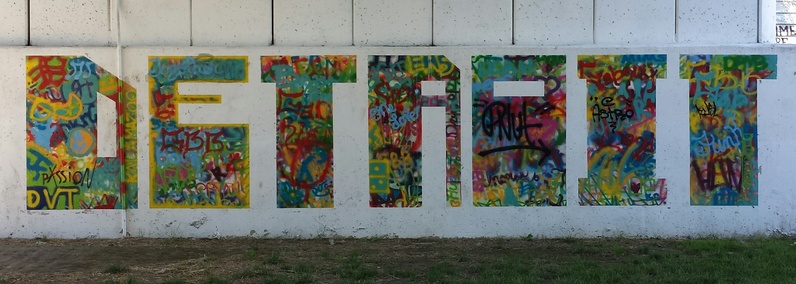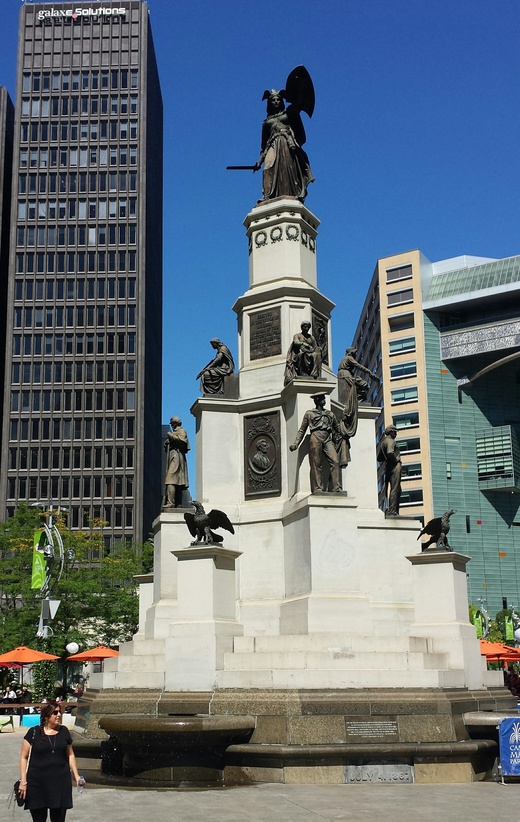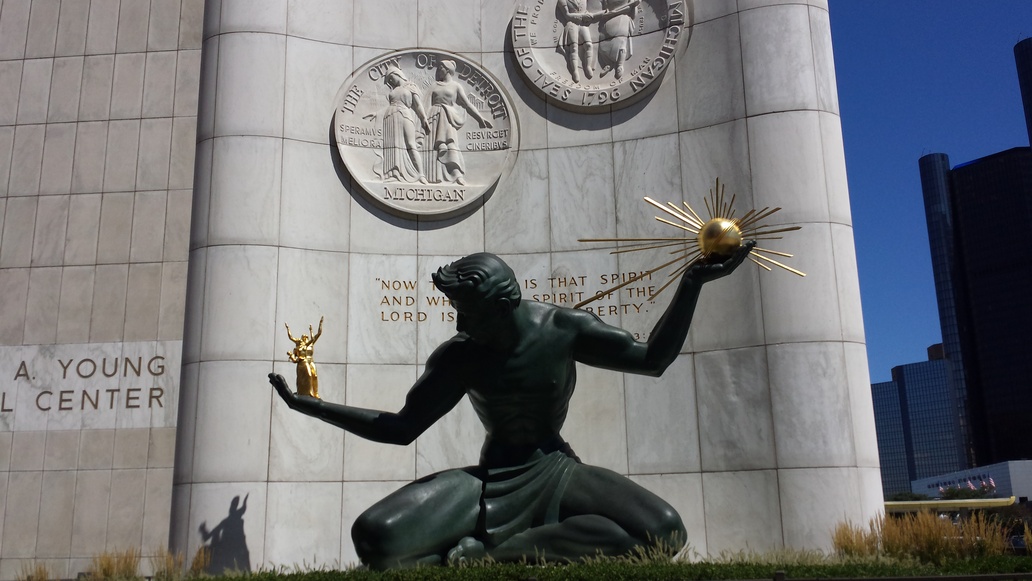
The area in and around the waterfront, Hart Plaza at the foot of Woodward Ave, has been a focus of revitalization. The area features the Renaissance Center, the Coleman A Young building, and lots of public art. This is the Spirit of Detroit statue. It is often parodied, shown holding various objects such as food to advertise a restaurant.
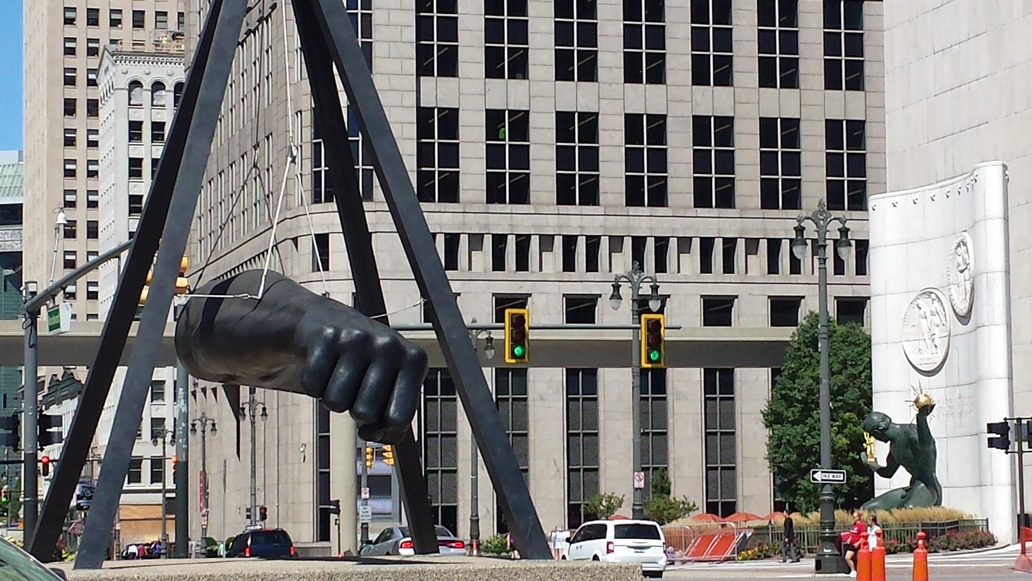
The Joe Louis Memorial. In the background to the right is another view of the Spirit of Detroit.

This looked like a monument to the first tokomak (a physics thing), but it actually a fountain. Water pours out of the tokomak and lands in and around the pool container below. The young man off to the right is about to run up one of the legs of the fountain.
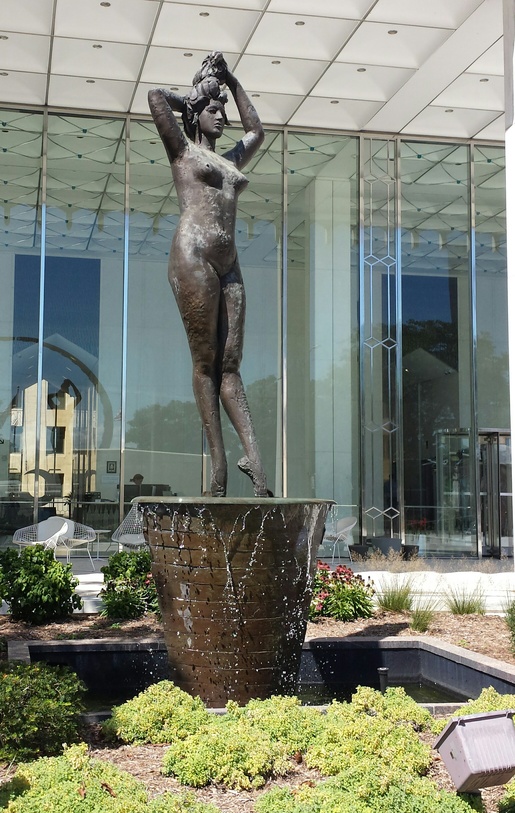
A random statue near Hart Plaza.
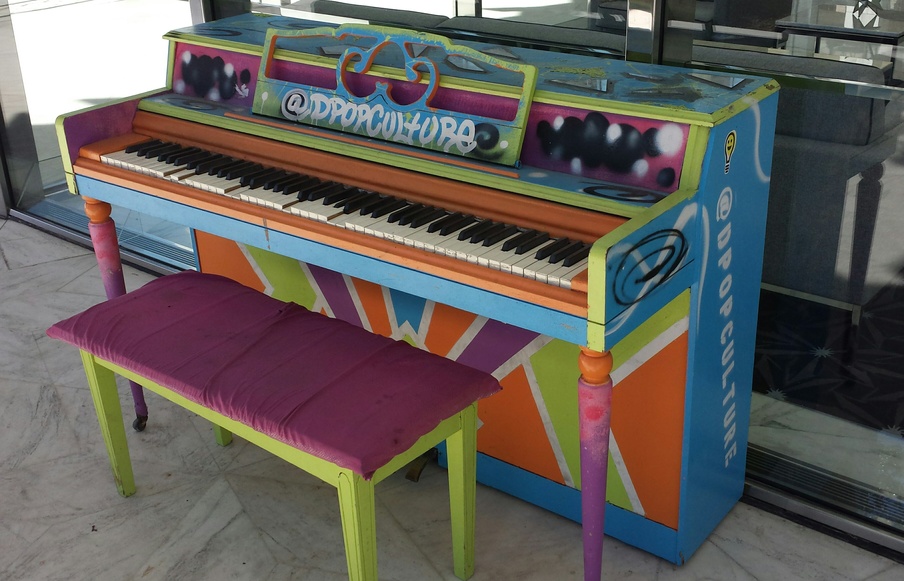
A painted-up piano near the statue. I don't know if it works. It looks like a found object, re-purposed. Detroit has a lot re-purposing going on.
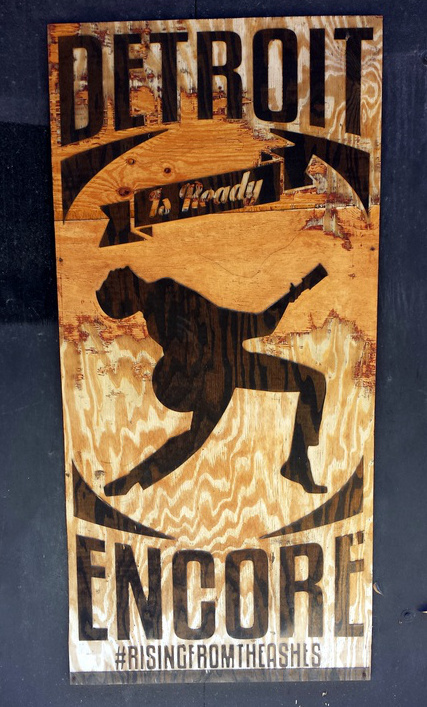
Detroit boosterism. A poster in a shop window.

Art placed on a currently-unused building. The black-and-white panels are labeled “From Detroit.” Portraits of famous Detroiters? I have no idea.
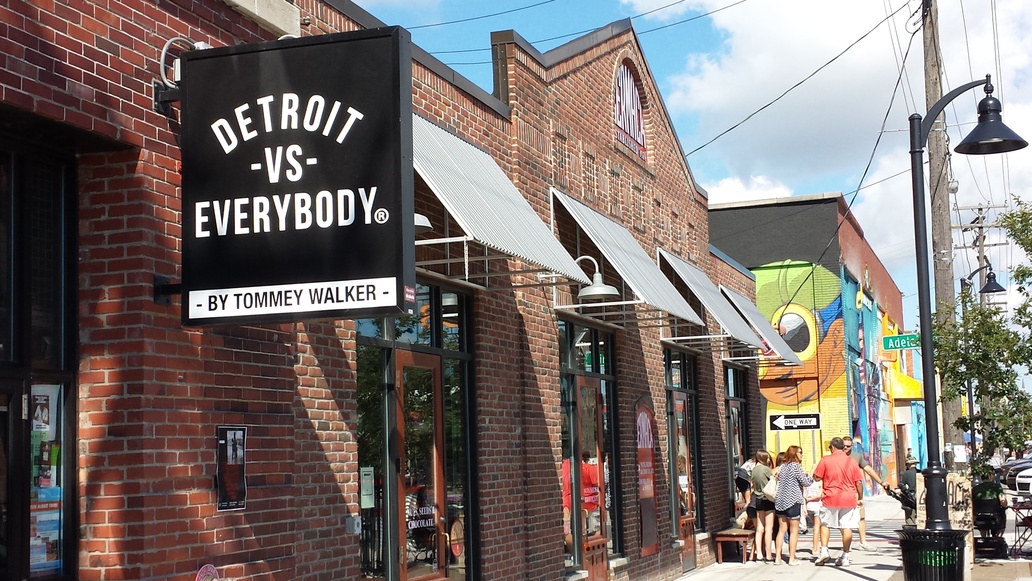
Detroit. The little city that could. The Spirit of Detroit seems to be that a good city needs good people more than it needs a “strong economy” and, by the by, the nay-sayers aren't helping. Do they ever? And could they please shut up?
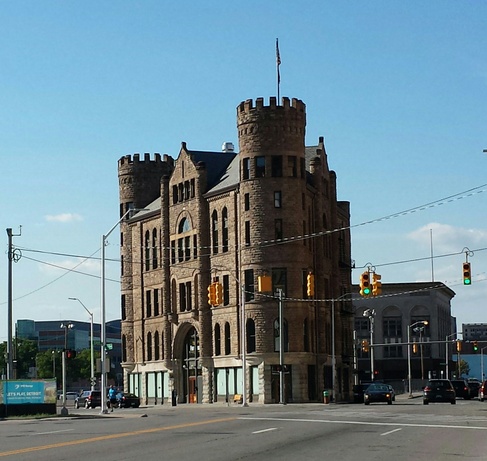
Downtown Detroit is a jumble of old, new, shiny and abandoned. This cool-looking building looks like it is waiting for a city to spring up around it.

Cool-looking (to me) transit center.
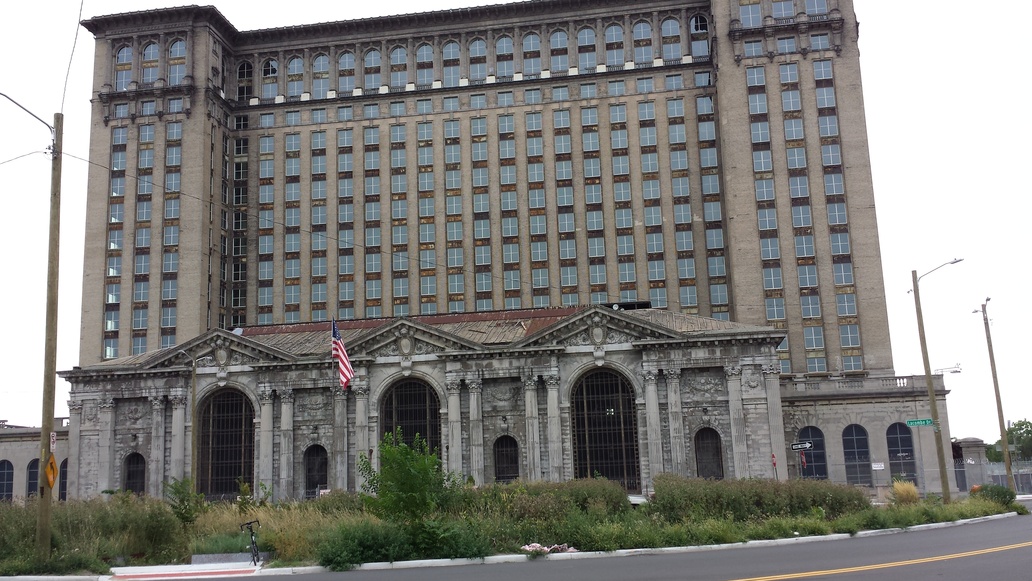
Michigan Central Station is a landmark despite being in a state of decay. Maybe someday Detroit will develop enough rail travel to support it as a train station. In the real world, thriving cities thrive on mass transit because that's what it takes to move enough people to make some real money. Cool that it hasn't been torn down (the billionaire who owns it seems to be patient).
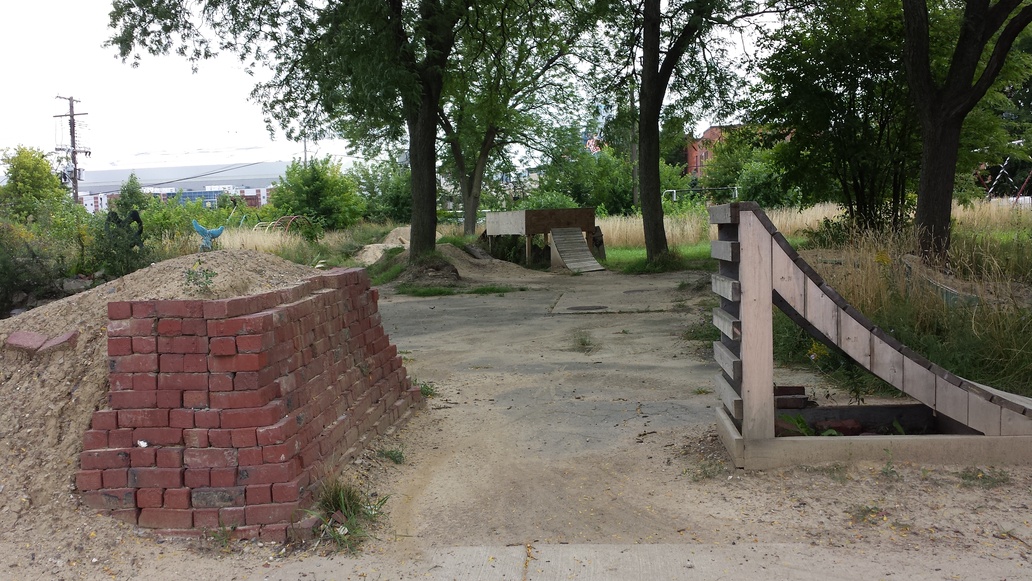
This this is an overgrown playground. Playground equipment can be seen among the weeds in the background. It seems to have been adopted by some people who are into the mountain bikes. Sort of a D.I.Y. skatepark, except for mountain bikes instead of skateboards.
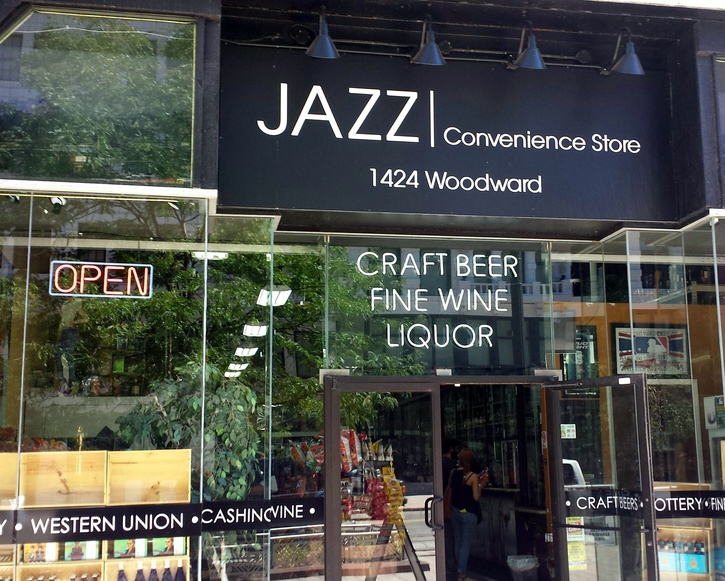
Odd name for a convenience store. Good for getting supplies in between sessions of doing that jazz, so to speak. For more on Jazz in Detroit, see my notes on the 2016 Detroit International Jazz Festival.
Slow Roll
I had heard of Slow Roll and wanted to check it out. It's really just a big group ride, but unusually multi-cultural. Other groups that gather to show off their tricked-out bikes exist in other cities, but are more exclusive. Other large social rides, at least those in Washington DC, tend to be dominated by younger folks.
This was inclusive in terms of age, color and class. The prevailing attitude seemed to be part and parcel of the D.I.Y. culture that is evident all over this city.
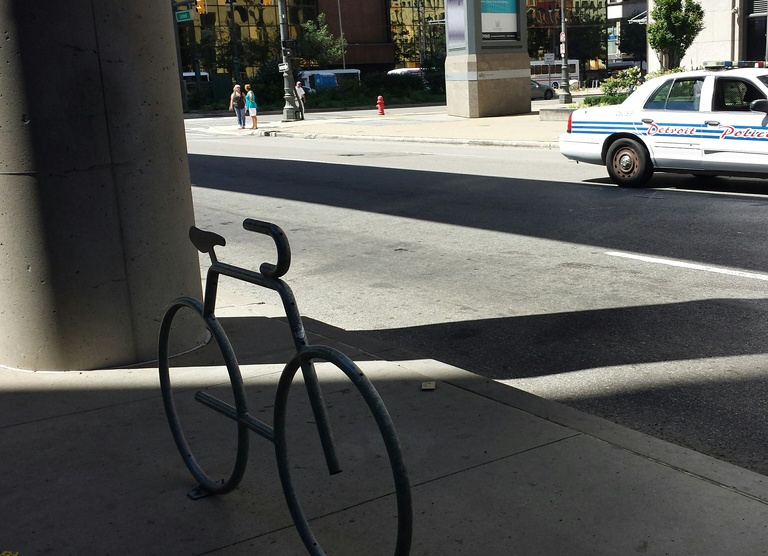
Cool bike parking. Nearby (not shown) is a cool bikeshare station. Sadly, there were few bike lanes. Bike lanes cost almost zero in terms of dollars, but can be expensive in terms of political capital. Either the Mayor can't spare the political capital or they just don't “get it.” I find the latter hard to believe in a city that so effectively demonstrates how much can be done with creativity instead of money, but I simply do not have the story on this one.
Initially, the few people I saw riding were on sidewalks. The first people I saw riding in the street were on bikeshare bikes. The cool thing about bikeshare is that it is obviously supported by the city. People on bikeshare bikes feel empowered to ride in the street, with or without bike lanes. Despite (or maybe because of) this, bikeshare bikes have a great safety record.
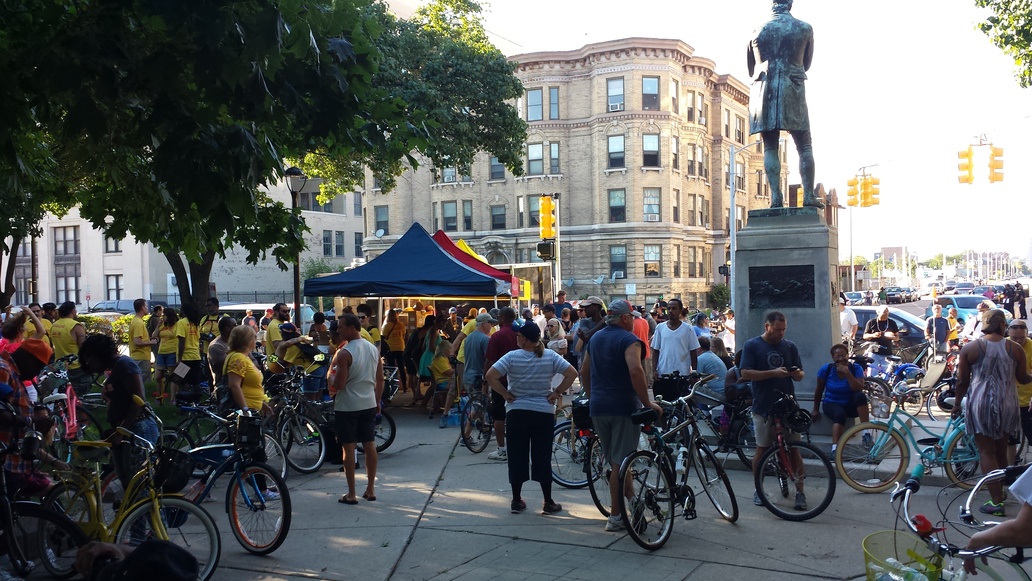
The weekly Slow Roll bike ride goes, slowly, through different neighborhoods for each ride. It attracts hundreds of people and has a police escort. Slow Roll showed me my first view of neighborhoods with grass where houses used to be. All that green space looked like parkland. Some of it probably was parkland.
I mainly talked to people who weren't talking to thers at the moment. Several were also on their first Slow Roll. Two others were tourists like me, who wanted to check this out while visiting from out of town.
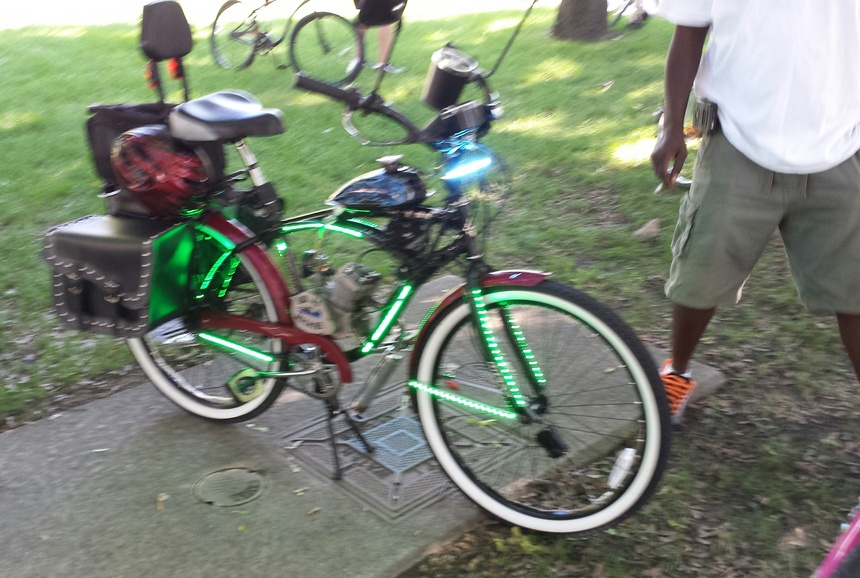
Many of the bikes were tricked out and some riders were dressed up (there was a prom theme at the after party with prizes). Riders and bike-builders were proud of their handiwork. (Sorry about the blurry photo).
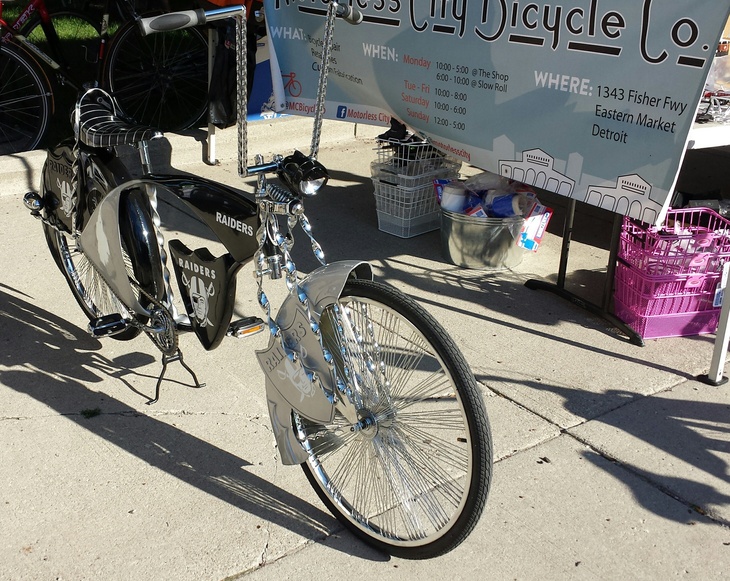
Custom bicycle from Motorless City.
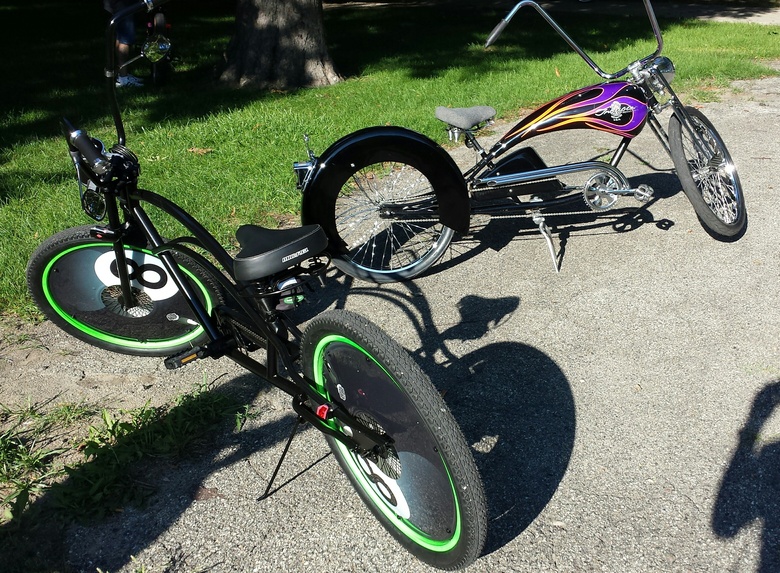
Tricked out bikes.

On the 13.5 mile ride we covered parts of West Detroit and then returned to downtown via the Mexico Town area. My hotel is near the right edge of the map, so I never got more than 5-6 miles from where I started. That's true of pretty much everywhere I went.
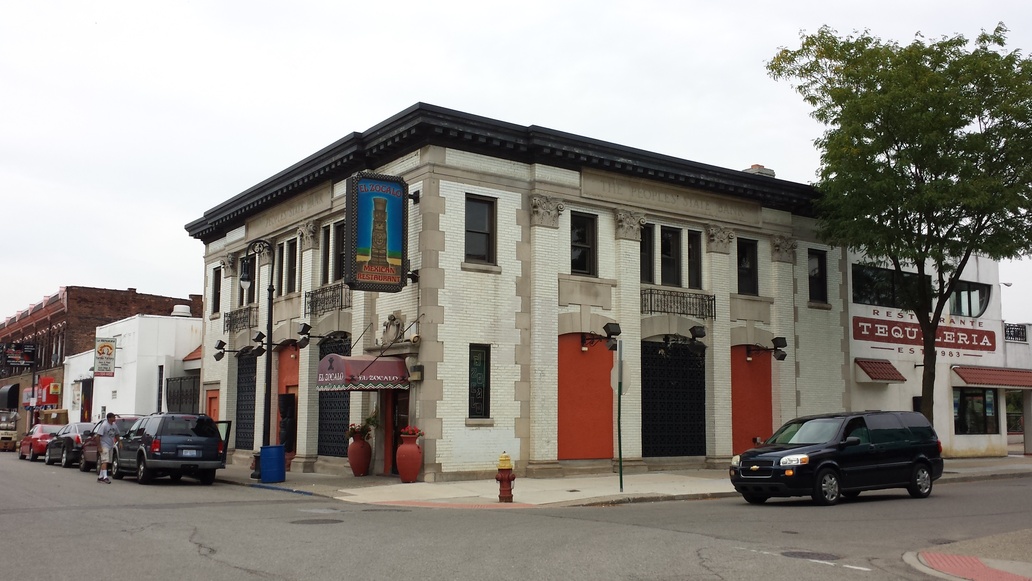
The next day I had lunch in this commercial area of Mexico Town. Good food in the one restaurant I tried here. Detroit is not a great food town and meals were very hit and miss. In retrospect, maybe I should have used my bike to get back here again. I wasn't impressed with the food within walking distance from my hotel.
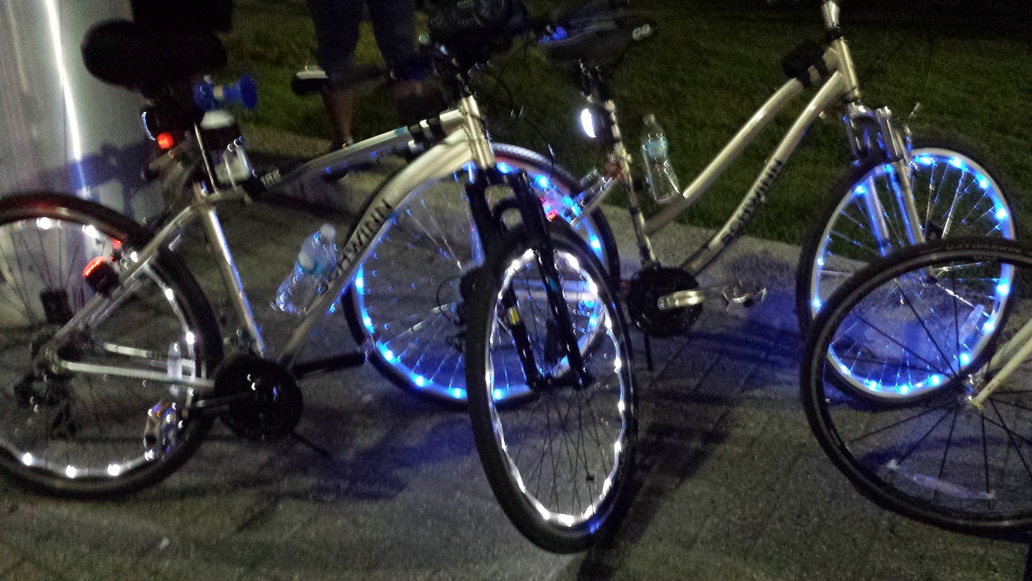
I saw quite a few tricked out bikes during my week long visit, including some playing music, which is common on Slow Roll rides (also on Critical mass Rides and DC Bike Party rides). Music is encouraged, but super-loud music systems are discouraged at Slow Roll. I talked to the owners of these two bikes, spotted at the Jazz Festival, and they were indeed Slow Rollers. Everyday tricked out bikes would be great to see anywhere, not just Detroit.
My own christmas-light laden "grocery store" bike would have fit right in.
Heidelberg Project
Damaged houses. Found objects. Art. Since 1986. Soon to be dismantled. While riding through residential areas I saw many cleared lots where houses used to be. I saw a crew clearing a lot and several freshly cleared lots, each with a large rectangular dirt patch where the remains of a structure had been removed.
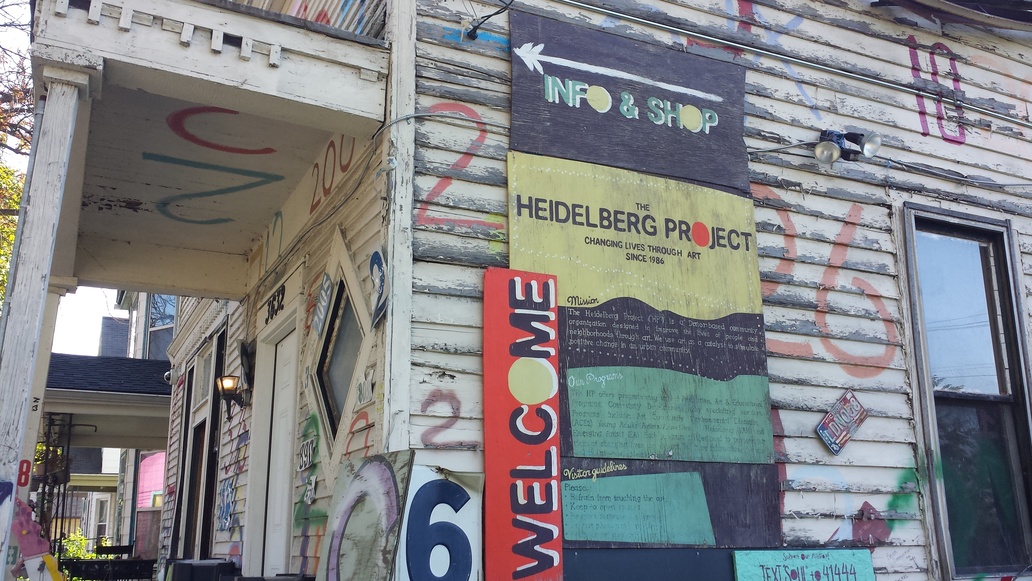
Numbers house and gift shop. The gift shop wasn't open, so missed out on that.
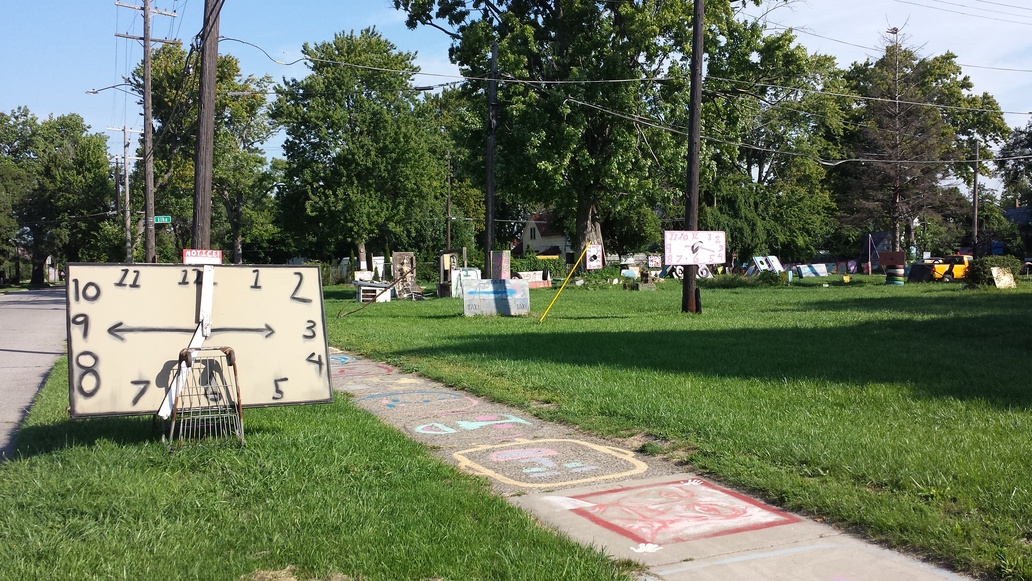
This was my first view of the project. As in other places, it is not clear if any of this was parkland or if it is all cleared land where houses used to be. Clocks were an unrelentling theme.
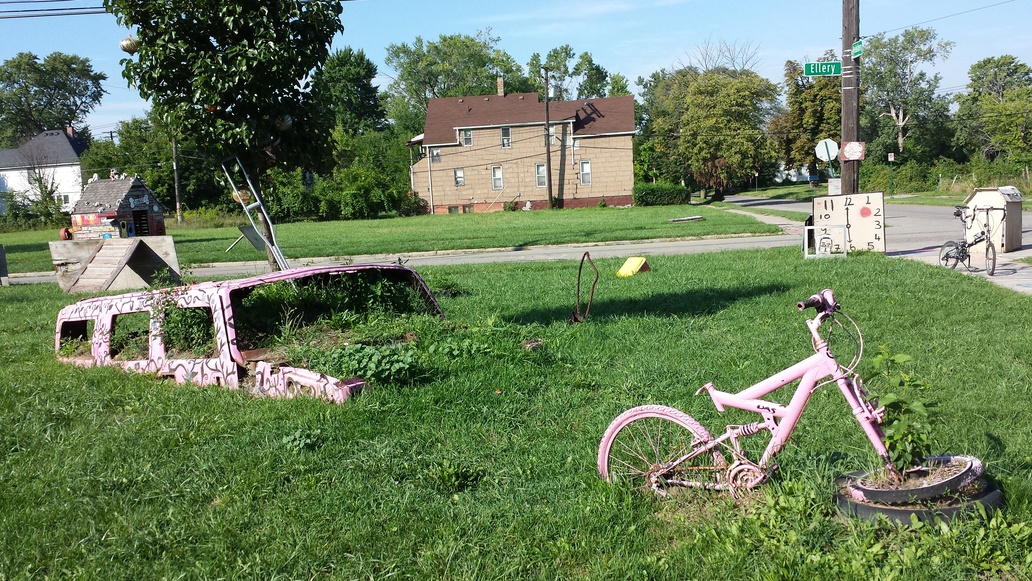
Found objects. Pink paint. A lawn-mowing service. Key elements of public art? The photo shows the Two of the larger art objects in a grassy lot. In the center of the lot was a shed that had been decorated. The shed was an open art gallery with text, photos and other documents related to the project. In effect, this is the Heidelberg front lawn. Imagine a front lawn with an abandoned car that sits so long that it sinks into the ground.
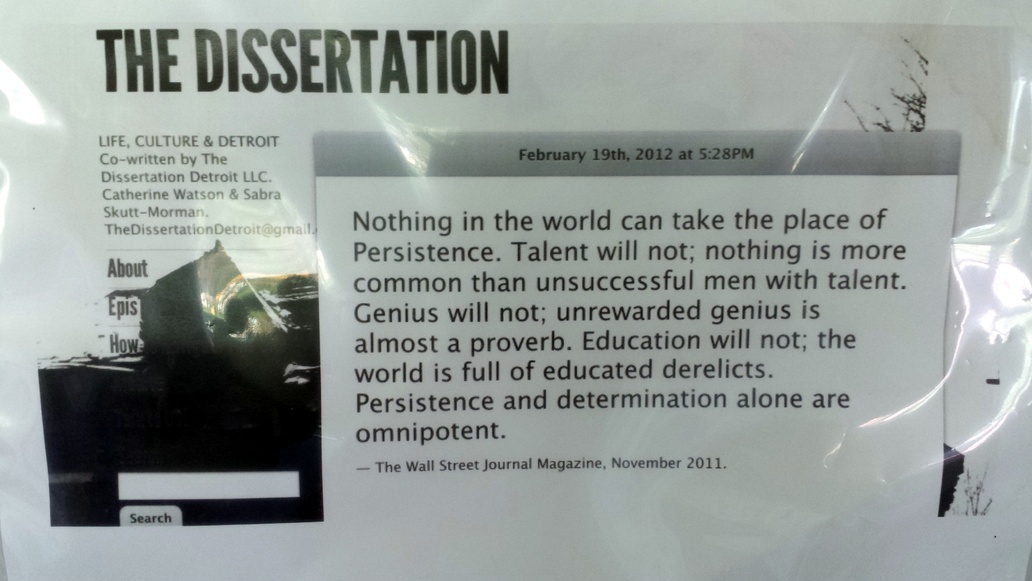
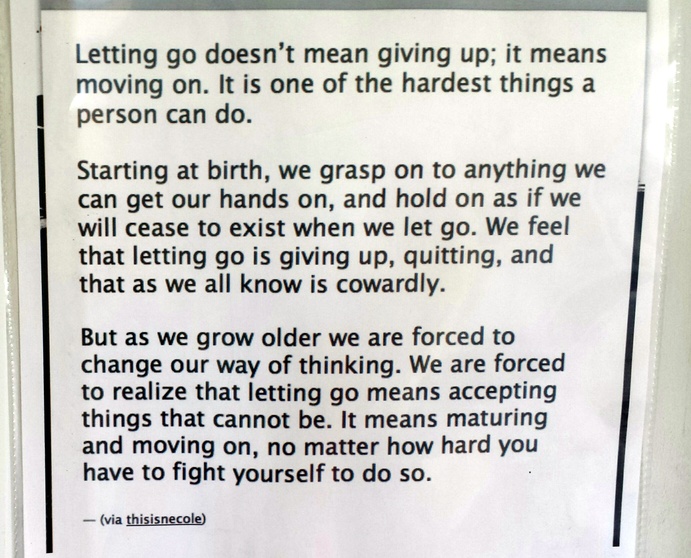
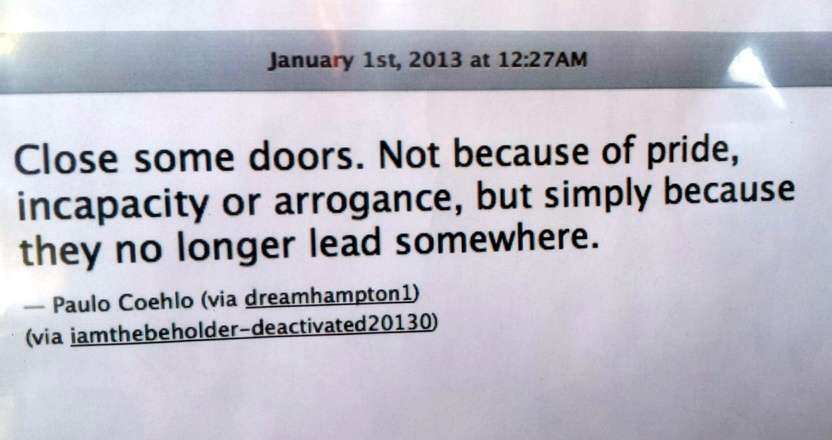
These are cropped photos of documents posted in the shed/gallery. Persistence and transformation are themes. Quotes are from a Wall Street Journal article and other electronic sources.
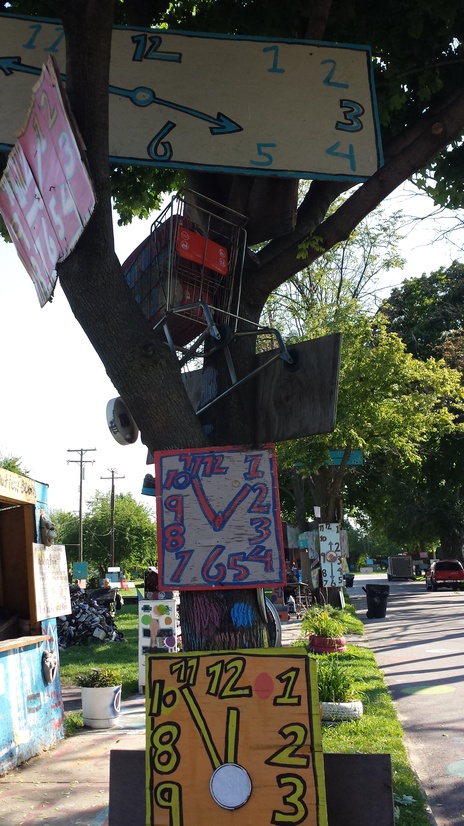
More clocks. I'm guessing the clocks are painted on boards that had been used to board up houses. I noticed a truck nearby that was full of old TV sets. It made me think that the people dismantling the project were taking out the toxic electronics first. Or maybe someone was collecting TV sets for another art project. The Heidelberg Project includes several instances of similar or nearly-identical objects gathered together to multiply their impact. Or maybe to hint at the scale of abandonment and displacement that took place.
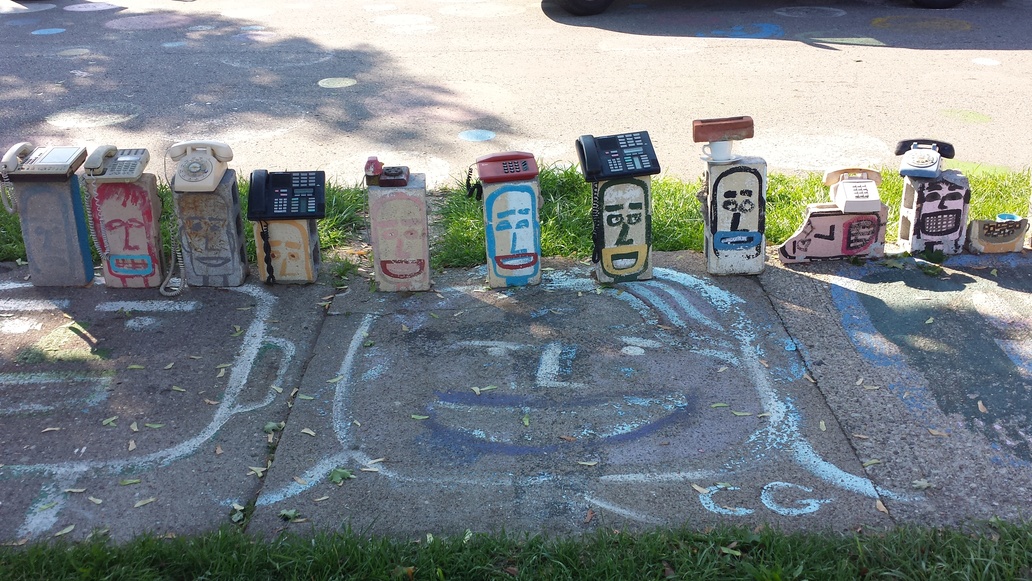
Among the abandoned houses, abandoned technology.
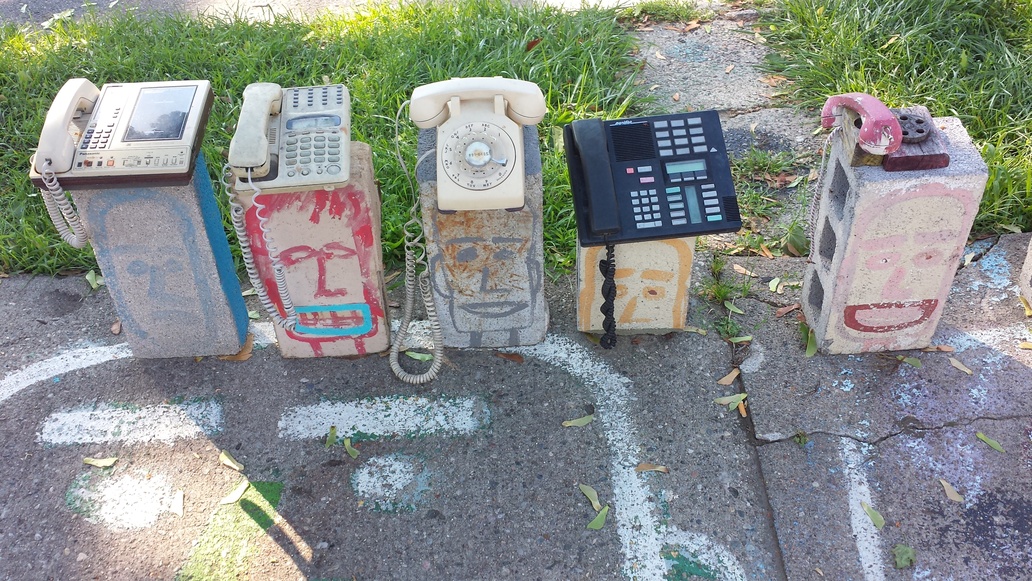
A closer look. For our purposes, a toy phone is about as useful as a broken landline phone. I don't think a child today would know what to do with any of these.
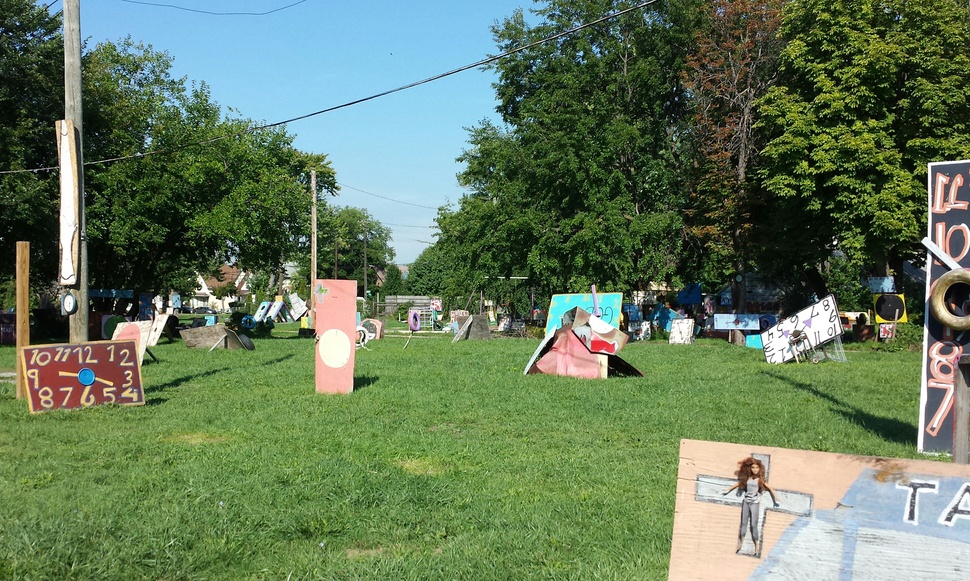
The Heidelberg Project stretches behind the houses, over to the next street. Abandoned lots. Parkland. If consolidated, Detroit could have the biggest urban park anywhere. Behind me as I took this photo were two houses that had residents. Signs indicated that residents did not wish to be photographed. To my left was a house that also wasn't part of the project (more on that further below, just before just before midnight).
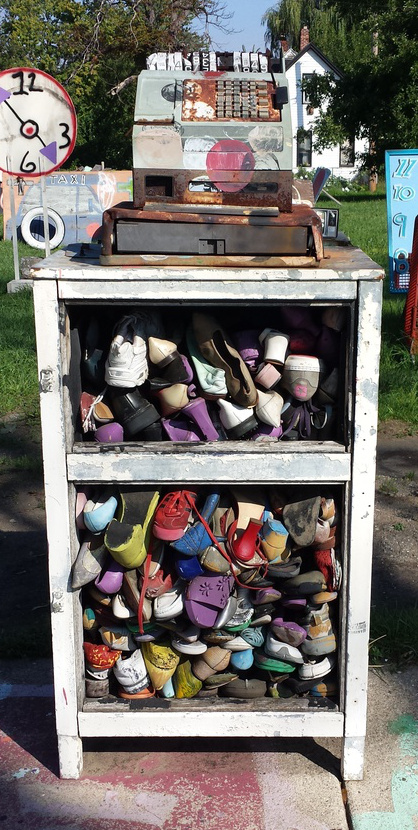
Shoes and cash register. The people aren't here to be counted, but the shoes are. In the background, more clocks.
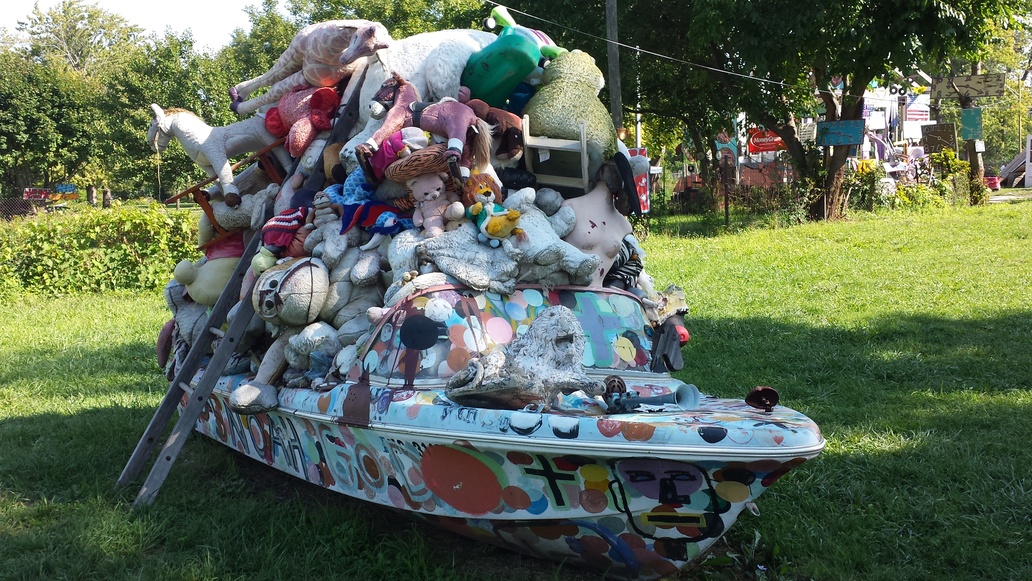
The ship of refugee stuffies. Yet another agglomeration of abandoned objects, looking for a home.
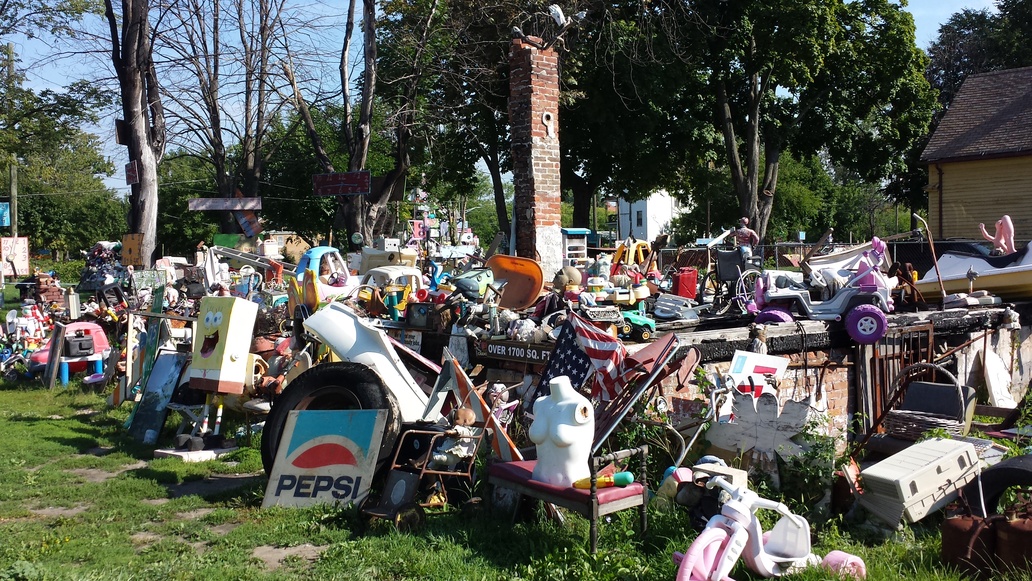
Burned-down house with found objects. For some reason this one was poignant to me. People used to live here. The objects reminded me of the personal objects that are typically left at a roadside or grave-site memorial, only larger. After the fact, the boatload of stuffed animals in the previous photo kind of got to me too.
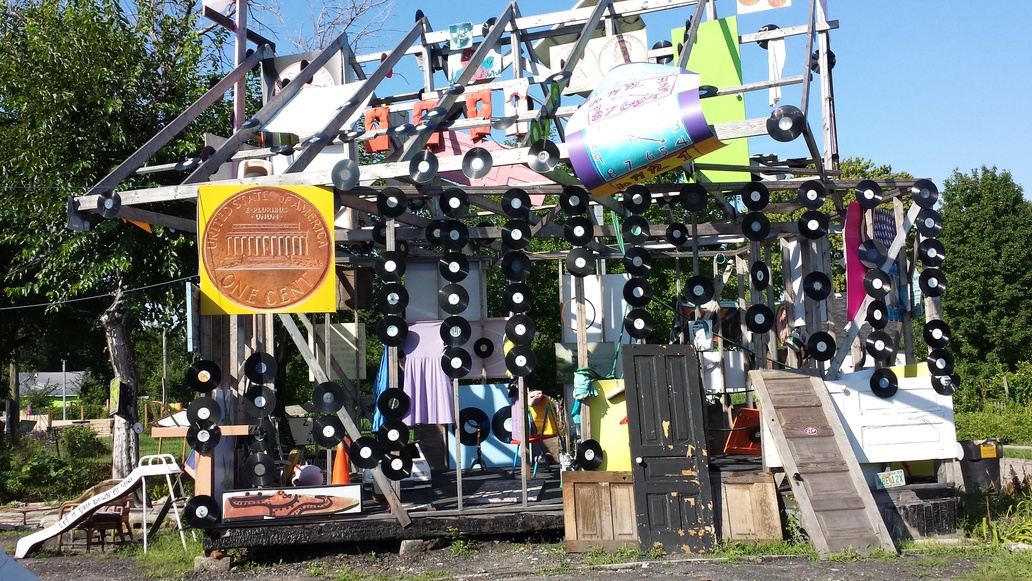
A frame placed on a burnt-house foundation. Vinyl siding (phonograph records). Another example of bringing together like objects.

1 of 2. Exterior. The white polar bears reminded me of ghosts. Note the window offering a view of the basement.

2 of 2. A view of the basement. The blue objects are shoes.
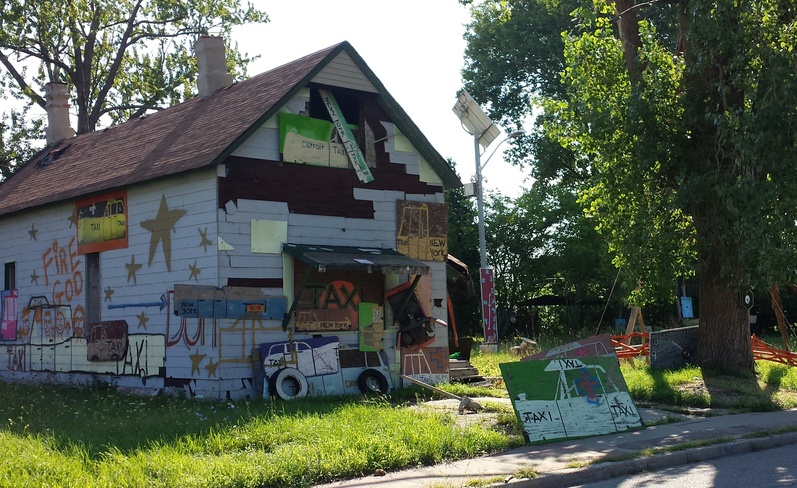
Taxi house.
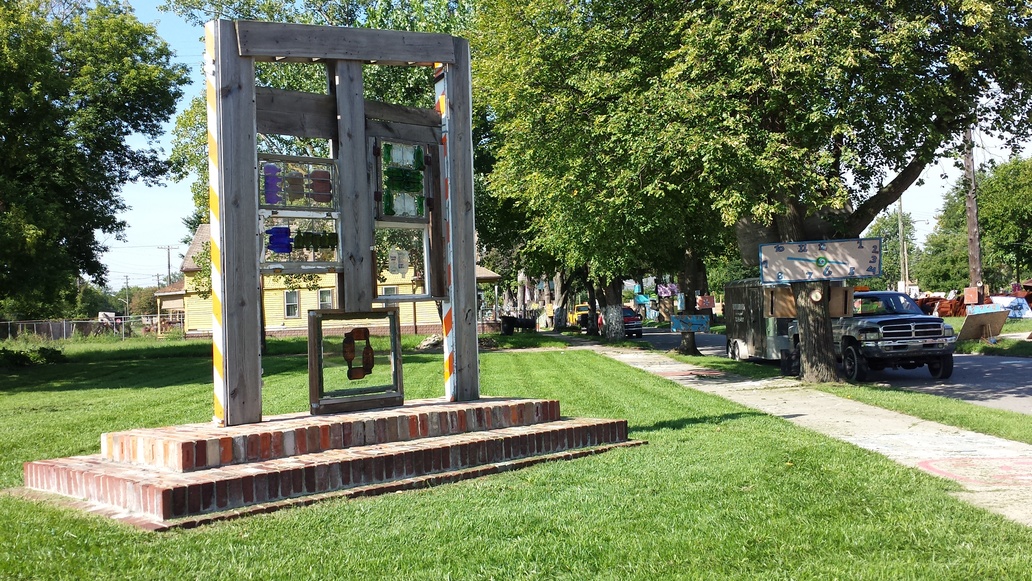
Sculpture of found objects, but without the Folk Art flavor of most other objects of the Project. This features window-frames containing melted-flat glass bottles for a stained-glass effect. I find myself thinking that this durable-looking piece ought to be part of a park, thus preserving part of the Project.
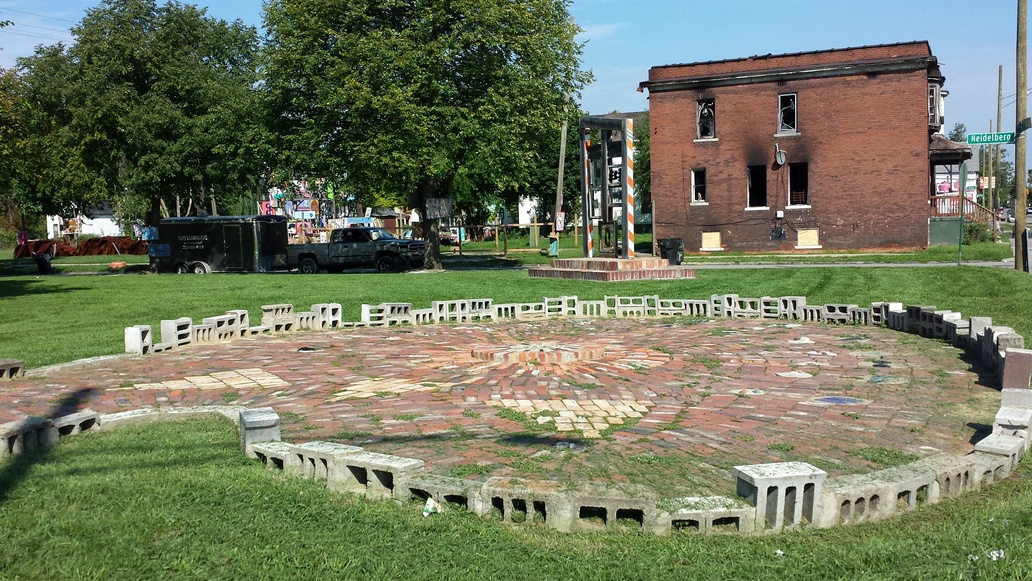
1 of 3. Bricks, enameled bricks, melted bottles, tile fragments, etc. The construction of this seems durable, but the lawn is already working to claim it.
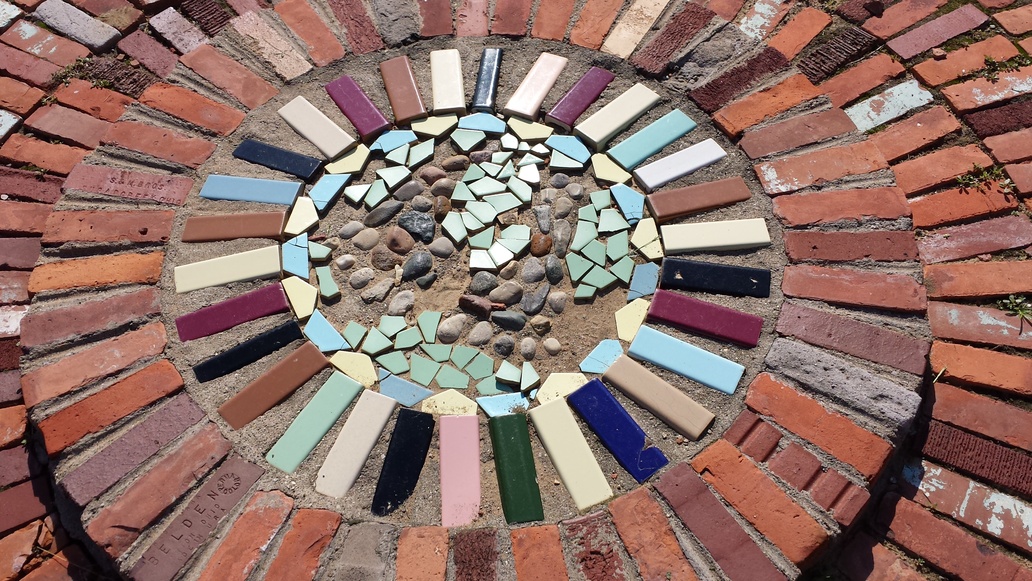
2 of 3. Detail. Center of the circle.
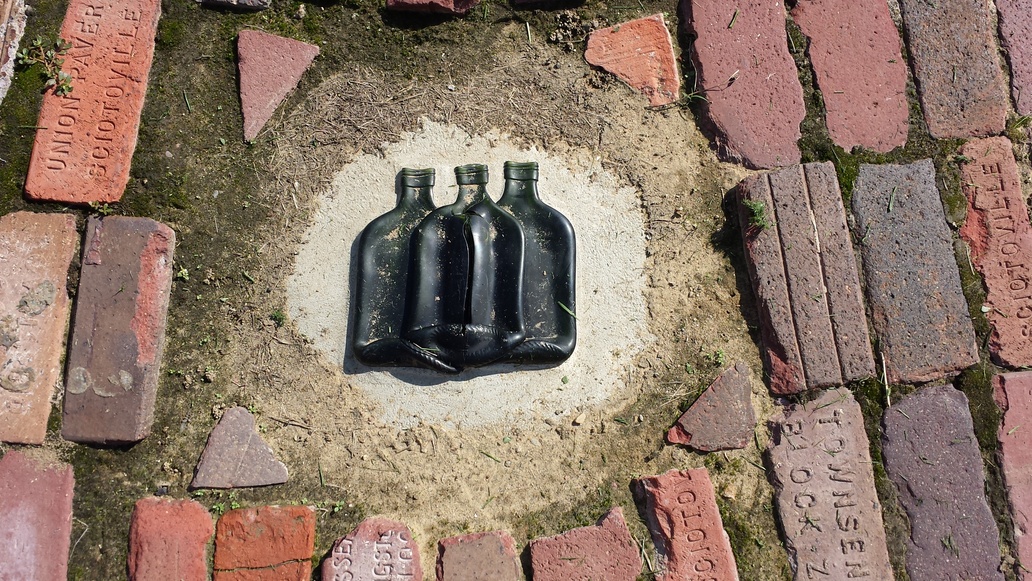
3 of 3. Detail showing melted bottles embedded among the bricks.

One house on the street was well-kept, with a yard showing numerous sculptures. The sign says “This is Not Heidelberg Project.” Another sign, not shown, advertises the artist.
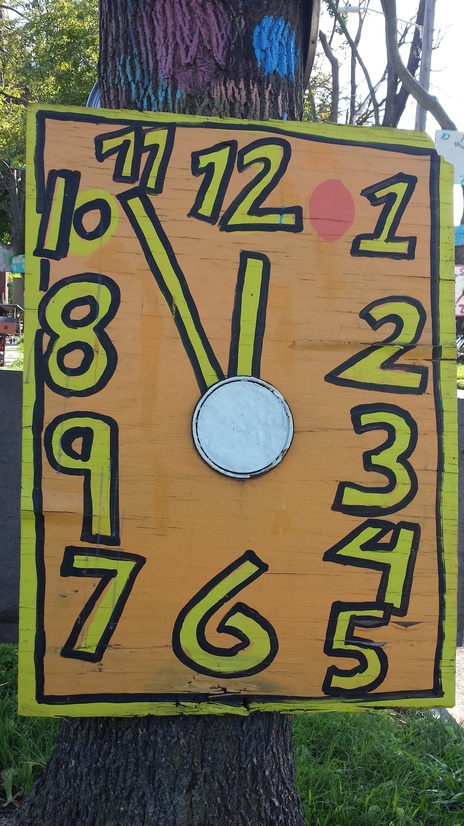
Nearly midnight on Heidelberg Street.
Belle Isle (and other bits of whimsy)
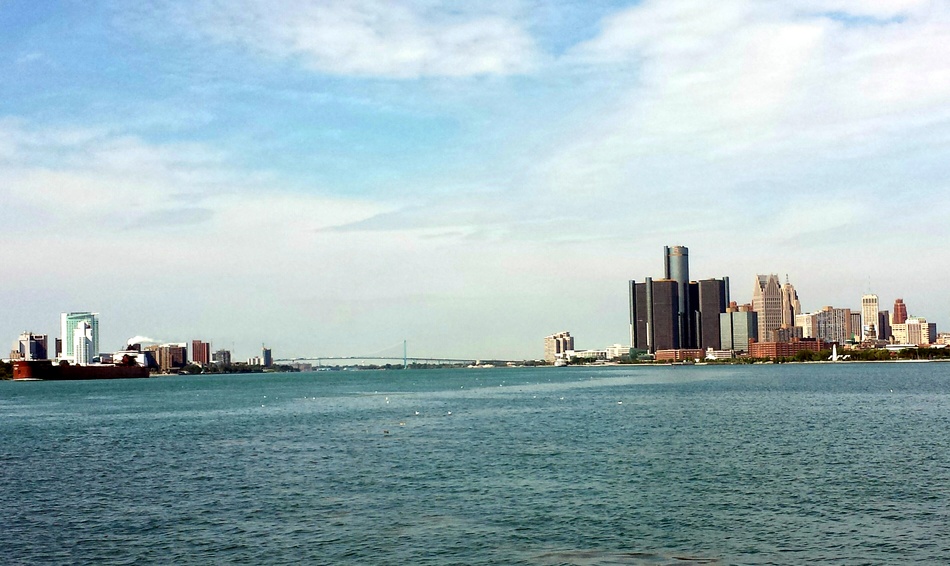
Belle Isle is in the river separating Detroit (USA) from Windsor (Canada). It's a nice place to ride a bike. This is a view of the river and the Ambassador Bridge. That big thing to the right is the Renaissance Center (part hotel, part GM headquarters; Goddess knows what else is in that thing). Sadly, riding my bike over to Canada wasn't an option. The Amaassador Bridge doesn't have a rideable sidewalk or bike lane and there is no public transit that carries bicycles. You have to get someone to drive you over.
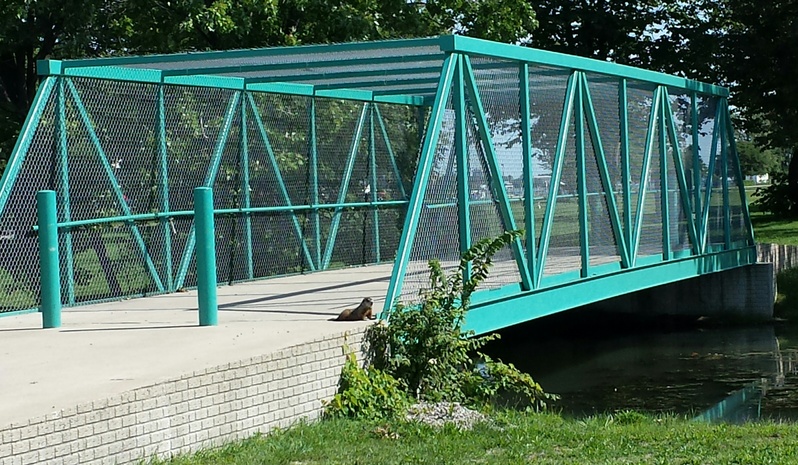
After seeing all the odd objects in the Heidelberg Project, I paid more attention to whimsical structures elsewhere in the city. I think this bridge on Bell Isle fits that theme because of the color and because other bridges and structures on Belle Isle also seemed whimiscal. They were certainly varied in their design. The otter was a nice touch.

This underpass, in a completely different part of town, was another bit of whimsy. It once carried the Grand Trunk Railroad past the Ford Piquette plant (see below). I think most cites need more whimsy. And more railroads.
Motown
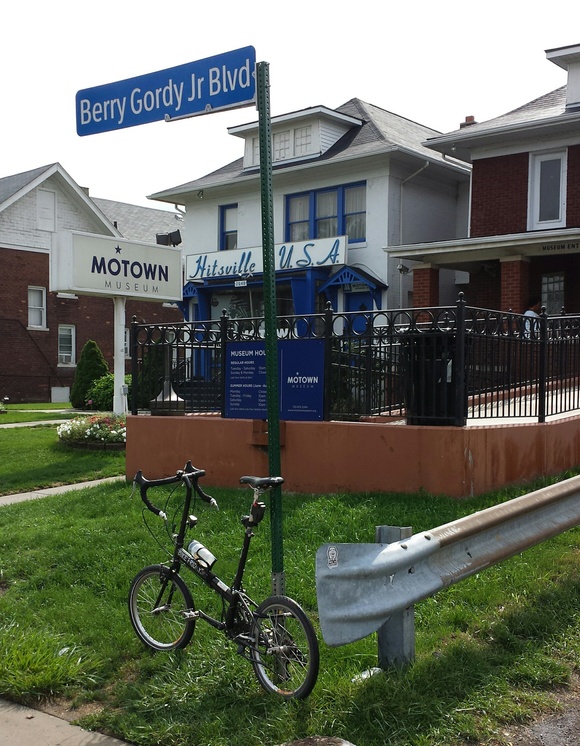
Motown music recording company, Detroit. By the time Motown moved to LA in 1972, they owned 8 houses on this street (West Grand Blvd). The first, with the Hitsville USA sign, contained Berry Gordy Jr's apartment, the front office, and historic Studio A. The second was the main business office and is now the museum-exhibit half of the museum. One of the other houses was used to mock up the stages of various clubs, to exact dimensions, so performers could rehearse dance routines. Other houses were used to stock and ship records. While in Studio A, they recorded on 2, 3 and 8 track tape, upgrading over time. The 3 track mixing board that is there now looks very primitive. My bicycle is in the foreground.
The museum contains lots of gold records and other artifacts. The upstairs echo chamber, in what is now the museum, is open for use (you will be invited to sing). No photos were allowed in the museum. Otherwise worth a visit.

On the way back from Motown I stopped at the Detroit Institute of Arts for lunch. In this beautiful setting, I enjoyed one of the better meals I had in Detroit. It looks like a movie set but mainly reminds me that food in Detroit was very hit and miss.
Ford Piquette Avenue Plant
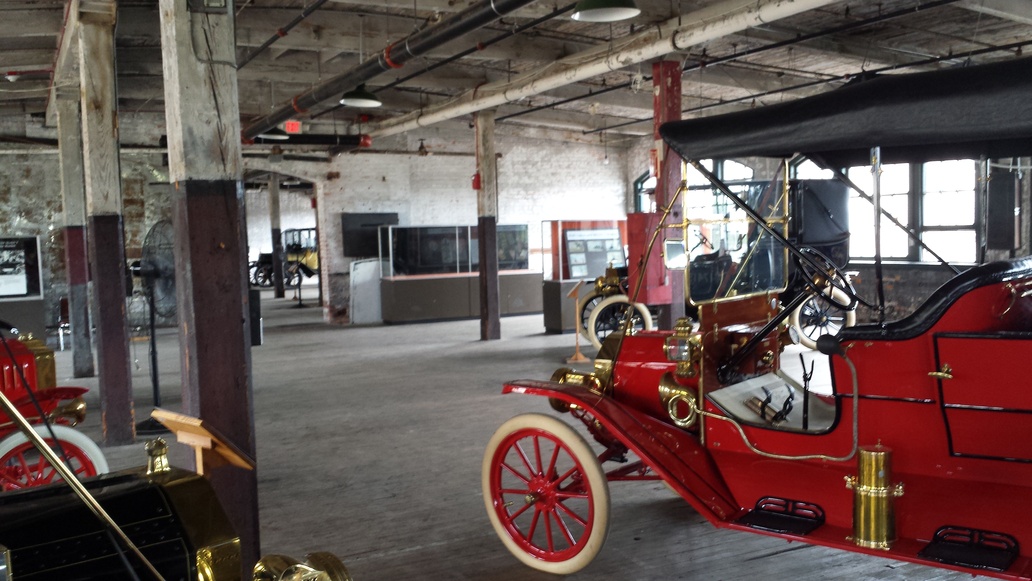
This was the first Ford factory and is a historic site under the purview of the National Park Service. This plant predated the assembly line, with cars being built at assembly stations. In fact, the story of how a slaughterhouse gave Ford's staff the idea for the assembly line isn't quite true. It first gave them ideas for speeding up this plant. The assembly line had to wait until the next plant was built.
Ford models B up to T were produced here (before this they rented space in another factory building and produced the Model A). When talking to locals, I found that Piquette is pronounced more like “PACKit.” Like other early car factories, it is near several rail lines, including the Grand Trunk Railroad.
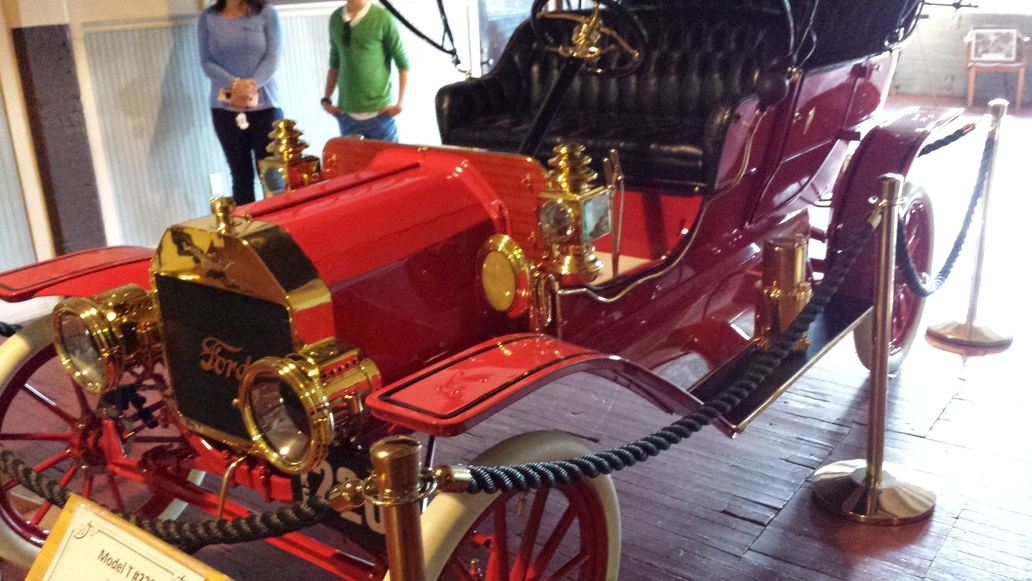
The main story here is the Model T. According to the docent who gave us a tour, Henry Ford gathered a few of his top engineers with the aim of using customer and dealer complaint information to identify and fix the weakest parts of his current model (the “N”). They ended up redesigning almost every part. The result was the extremely reliable Model T. It originally came only in red. Later it came only in green. Ford never said “any color you want as long as its black” because the idea of offering more than one color at a time hadn't come up.
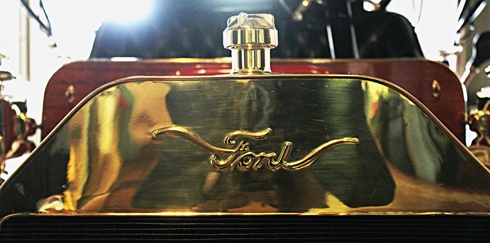
Another thing that hadn't come up yet was corporate branding. Fords produced at the Piquette Avenue plant can be identified by the logo. The “wings” were dropped when production moved to a larger factory in 1910. The now-common blue oval logo was introduced when Henry's son Edsel took over the company. According to the tour guide, that logo was retired when Edsel passed away. It was pressed back into service when some pioneer of marketing research discovered that, despite not being in use, the blue-oval was the second-most recognizable logo in the world, after Coca Cola. This is a photo I grabbed from elsewhere on the Internet.
I recently learned that you can freak people out by pointing out that the Ford logo has a funny curlicue (curyly q?) in the line that “crosses” the F. To freak people out, point out the curlicue and and ask “Do you remember that being there?” Followed this with “I don't remember that”, “I think something weird is going on” and “Must be a wrinkle in the Matrix.” I've never tried this so I don't know if it actually works.
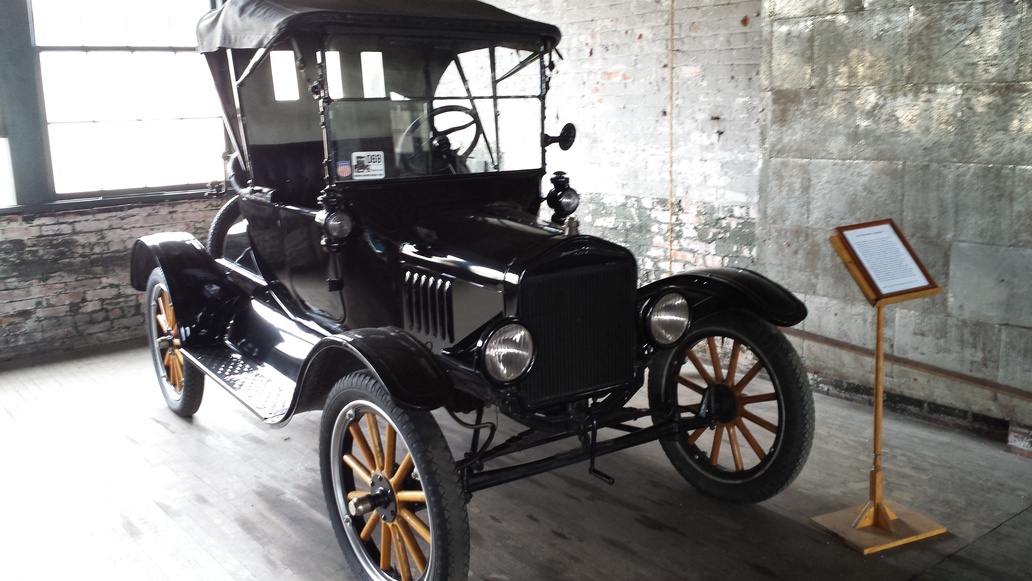
The newer Model Ts, from the Highland Park factory where Ford set up his first assembly line, were the iconic black color that everyone remembers. This 1916 car cost about $250 and was one of the least expensive mass-produced cars ever.
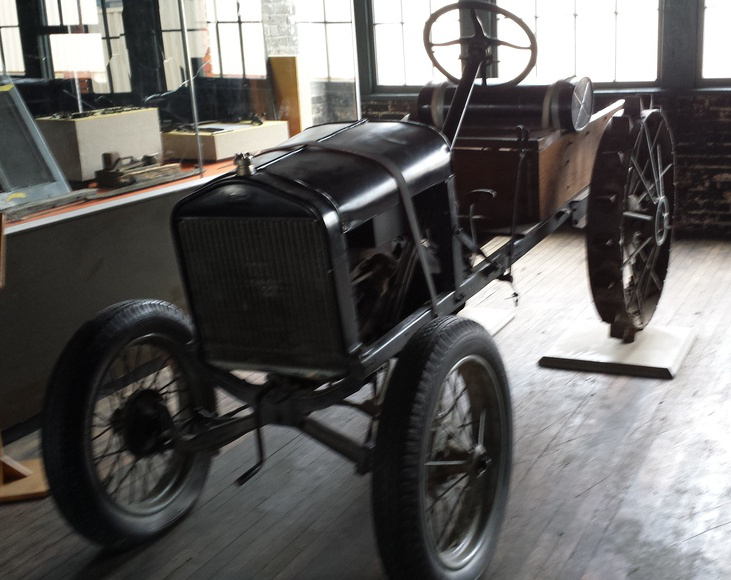
With the world awash with Model Ts (trade in value $25), enterprising entrepreneurs began to market add-on kits. This Model T was converted to a farm tractor.

Model T kit-conversion snowmobile. The Model T wasn't outsold until the Volkswagen Beetle went into heavy production after World War II. As a percentage of cars in active use, it was never out-produced.
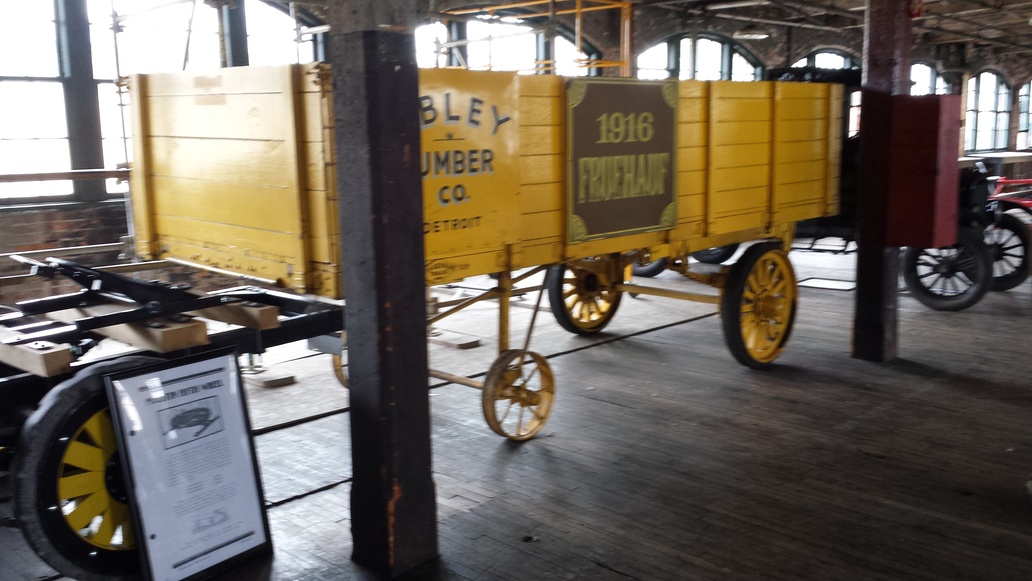
This is an early Fruehauf semi trailer. It was displayed alongside a Model T that had been converted into a tractor for a tractor-trailer (partially visible, to the left, with yellow wheels). People who are into trucking would appreciate this more than I.
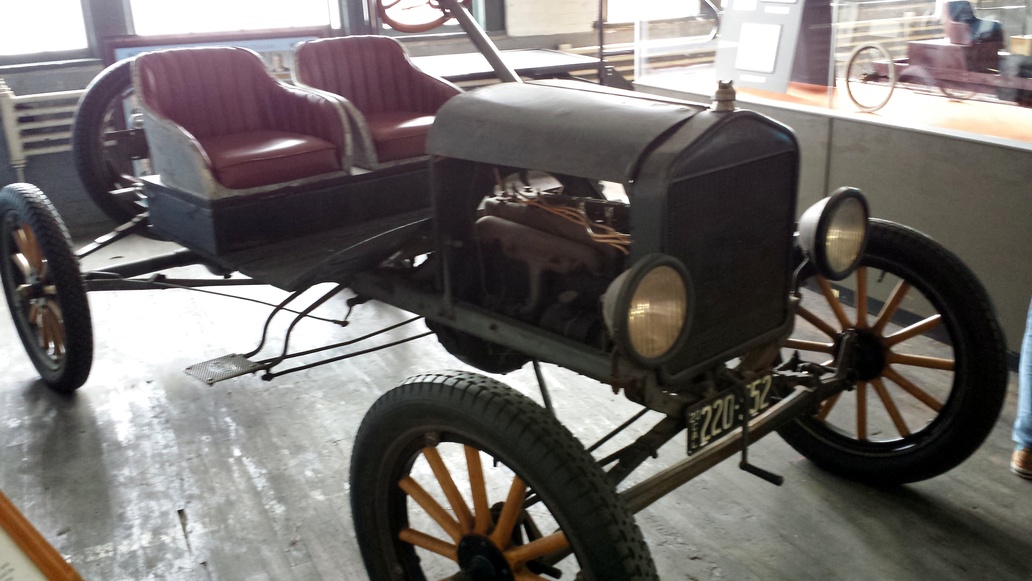
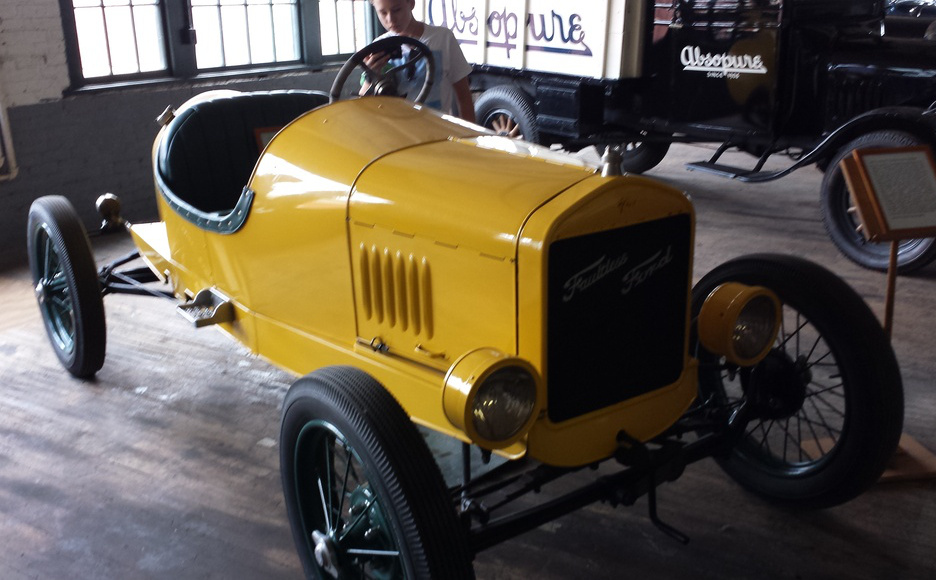
Model T kit-conversion racers. There is more to the story than the Model T. The Piquette Avenue Plant wasn't all Fords and the tour guide told interesting stories about the then-developing auto industry.
Eastern Market via the Dequindre Cut
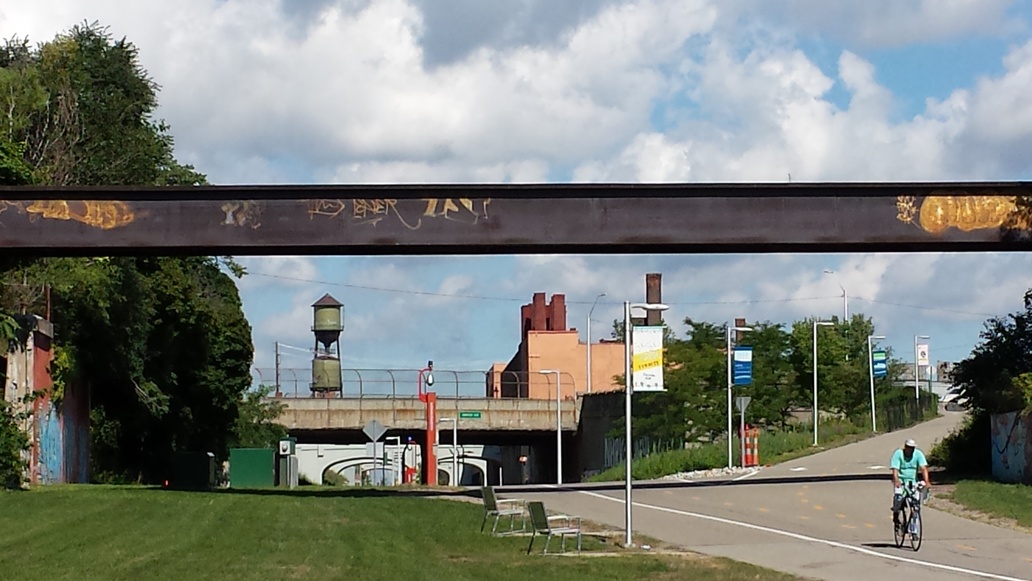
The Dequindre Cut is a below-grade biking/walking path following the old Grand Trunk Railroad. Graffiti art seems to be encouraged. I was told Dequindre is pronounced deKINder.
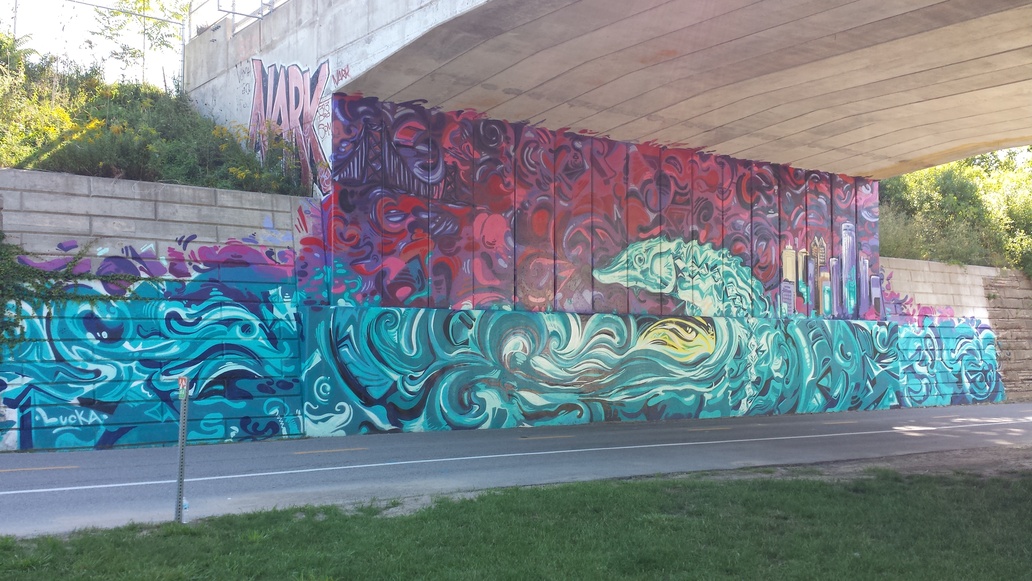
Dequindre Cut graffiti art.
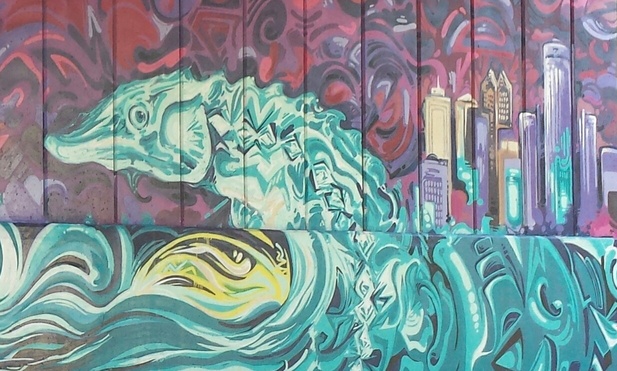
Dequindre Cut graffiti art (detail). Upper right depicts downtown Detroit.
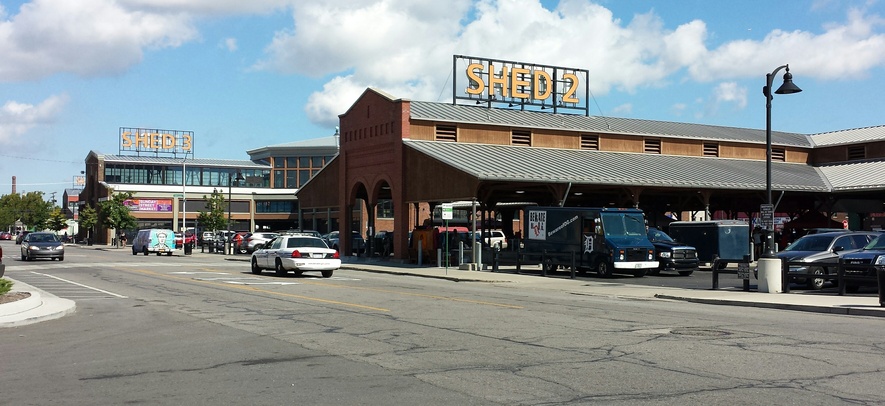
Eastern Market is a series of spaces used for farmers markets or craft fairs. When I passed through on Sunday morning two areas had dry goods for sale and one was selling food. I had planned to visit on Saturday, when the market is busy, but was distracted by the Detroit Jazz Festival.
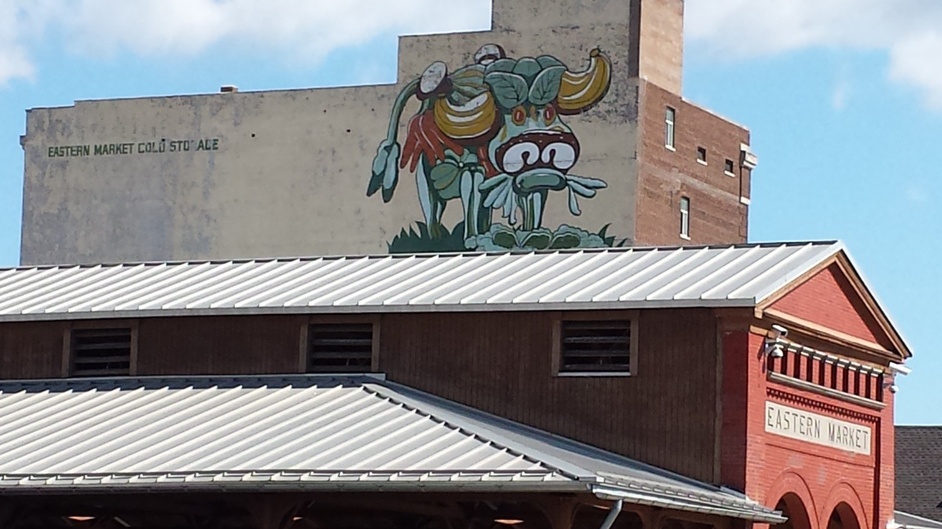
Eastern Market art

Dequindre Cut graffiti art with hearts, spades, clubs and diamonds.
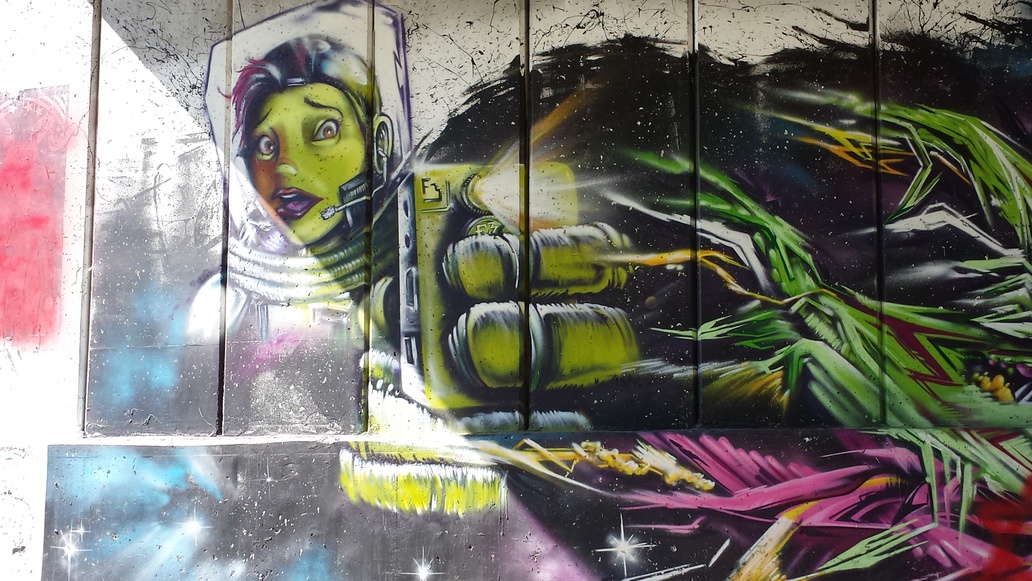
More Dequindre Cut graffiti art. I'm not sure, but I think the woman pictured is becoming her own iPhone. If you are looking at this on an iPhone, now would be a good time to stop. For your own safety. Thanks for reading.

Numbers house and gift shop. The gift shop wasn't open, so missed out on that.

This was my first view of the project. As in other places, it is not clear if any of this was parkland or if it is all cleared land where houses used to be. Clocks were an unrelentling theme.

Found objects. Pink paint. A lawn-mowing service. Key elements of public art? The photo shows the Two of the larger art objects in a grassy lot. In the center of the lot was a shed that had been decorated. The shed was an open art gallery with text, photos and other documents related to the project. In effect, this is the Heidelberg front lawn. Imagine a front lawn with an abandoned car that sits so long that it sinks into the ground.



These are cropped photos of documents posted in the shed/gallery. Persistence and transformation are themes. Quotes are from a Wall Street Journal article and other electronic sources.

More clocks. I'm guessing the clocks are painted on boards that had been used to board up houses. I noticed a truck nearby that was full of old TV sets. It made me think that the people dismantling the project were taking out the toxic electronics first. Or maybe someone was collecting TV sets for another art project. The Heidelberg Project includes several instances of similar or nearly-identical objects gathered together to multiply their impact. Or maybe to hint at the scale of abandonment and displacement that took place.

Among the abandoned houses, abandoned technology.

A closer look. For our purposes, a toy phone is about as useful as a broken landline phone. I don't think a child today would know what to do with any of these.

The Heidelberg Project stretches behind the houses, over to the next street. Abandoned lots. Parkland. If consolidated, Detroit could have the biggest urban park anywhere. Behind me as I took this photo were two houses that had residents. Signs indicated that residents did not wish to be photographed. To my left was a house that also wasn't part of the project (more on that further below, just before just before midnight).

Shoes and cash register. The people aren't here to be counted, but the shoes are. In the background, more clocks.

The ship of refugee stuffies. Yet another agglomeration of abandoned objects, looking for a home.

Burned-down house with found objects. For some reason this one was poignant to me. People used to live here. The objects reminded me of the personal objects that are typically left at a roadside or grave-site memorial, only larger. After the fact, the boatload of stuffed animals in the previous photo kind of got to me too.

A frame placed on a burnt-house foundation. Vinyl siding (phonograph records). Another example of bringing together like objects.

1 of 2. Exterior. The white polar bears reminded me of ghosts. Note the window offering a view of the basement.

2 of 2. A view of the basement. The blue objects are shoes.

Taxi house.

Sculpture of found objects, but without the Folk Art flavor of most other objects of the Project. This features window-frames containing melted-flat glass bottles for a stained-glass effect. I find myself thinking that this durable-looking piece ought to be part of a park, thus preserving part of the Project.

1 of 3. Bricks, enameled bricks, melted bottles, tile fragments, etc. The construction of this seems durable, but the lawn is already working to claim it.

2 of 3. Detail. Center of the circle.

3 of 3. Detail showing melted bottles embedded among the bricks.

One house on the street was well-kept, with a yard showing numerous sculptures. The sign says “This is Not Heidelberg Project.” Another sign, not shown, advertises the artist.

Nearly midnight on Heidelberg Street.
Belle Isle (and other bits of whimsy)

Belle Isle is in the river separating Detroit (USA) from Windsor (Canada). It's a nice place to ride a bike. This is a view of the river and the Ambassador Bridge. That big thing to the right is the Renaissance Center (part hotel, part GM headquarters; Goddess knows what else is in that thing). Sadly, riding my bike over to Canada wasn't an option. The Amaassador Bridge doesn't have a rideable sidewalk or bike lane and there is no public transit that carries bicycles. You have to get someone to drive you over.

After seeing all the odd objects in the Heidelberg Project, I paid more attention to whimsical structures elsewhere in the city. I think this bridge on Bell Isle fits that theme because of the color and because other bridges and structures on Belle Isle also seemed whimiscal. They were certainly varied in their design. The otter was a nice touch.

This underpass, in a completely different part of town, was another bit of whimsy. It once carried the Grand Trunk Railroad past the Ford Piquette plant (see below). I think most cites need more whimsy. And more railroads.
Motown

Motown music recording company, Detroit. By the time Motown moved to LA in 1972, they owned 8 houses on this street (West Grand Blvd). The first, with the Hitsville USA sign, contained Berry Gordy Jr's apartment, the front office, and historic Studio A. The second was the main business office and is now the museum-exhibit half of the museum. One of the other houses was used to mock up the stages of various clubs, to exact dimensions, so performers could rehearse dance routines. Other houses were used to stock and ship records. While in Studio A, they recorded on 2, 3 and 8 track tape, upgrading over time. The 3 track mixing board that is there now looks very primitive. My bicycle is in the foreground.
The museum contains lots of gold records and other artifacts. The upstairs echo chamber, in what is now the museum, is open for use (you will be invited to sing). No photos were allowed in the museum. Otherwise worth a visit.

On the way back from Motown I stopped at the Detroit Institute of Arts for lunch. In this beautiful setting, I enjoyed one of the better meals I had in Detroit. It looks like a movie set but mainly reminds me that food in Detroit was very hit and miss.
Ford Piquette Avenue Plant

This was the first Ford factory and is a historic site under the purview of the National Park Service. This plant predated the assembly line, with cars being built at assembly stations. In fact, the story of how a slaughterhouse gave Ford's staff the idea for the assembly line isn't quite true. It first gave them ideas for speeding up this plant. The assembly line had to wait until the next plant was built.
Ford models B up to T were produced here (before this they rented space in another factory building and produced the Model A). When talking to locals, I found that Piquette is pronounced more like “PACKit.” Like other early car factories, it is near several rail lines, including the Grand Trunk Railroad.

The main story here is the Model T. According to the docent who gave us a tour, Henry Ford gathered a few of his top engineers with the aim of using customer and dealer complaint information to identify and fix the weakest parts of his current model (the “N”). They ended up redesigning almost every part. The result was the extremely reliable Model T. It originally came only in red. Later it came only in green. Ford never said “any color you want as long as its black” because the idea of offering more than one color at a time hadn't come up.

Another thing that hadn't come up yet was corporate branding. Fords produced at the Piquette Avenue plant can be identified by the logo. The “wings” were dropped when production moved to a larger factory in 1910. The now-common blue oval logo was introduced when Henry's son Edsel took over the company. According to the tour guide, that logo was retired when Edsel passed away. It was pressed back into service when some pioneer of marketing research discovered that, despite not being in use, the blue-oval was the second-most recognizable logo in the world, after Coca Cola. This is a photo I grabbed from elsewhere on the Internet.
I recently learned that you can freak people out by pointing out that the Ford logo has a funny curlicue (curyly q?) in the line that “crosses” the F. To freak people out, point out the curlicue and and ask “Do you remember that being there?” Followed this with “I don't remember that”, “I think something weird is going on” and “Must be a wrinkle in the Matrix.” I've never tried this so I don't know if it actually works.

The newer Model Ts, from the Highland Park factory where Ford set up his first assembly line, were the iconic black color that everyone remembers. This 1916 car cost about $250 and was one of the least expensive mass-produced cars ever.

With the world awash with Model Ts (trade in value $25), enterprising entrepreneurs began to market add-on kits. This Model T was converted to a farm tractor.

Model T kit-conversion snowmobile. The Model T wasn't outsold until the Volkswagen Beetle went into heavy production after World War II. As a percentage of cars in active use, it was never out-produced.

This is an early Fruehauf semi trailer. It was displayed alongside a Model T that had been converted into a tractor for a tractor-trailer (partially visible, to the left, with yellow wheels). People who are into trucking would appreciate this more than I.


Model T kit-conversion racers. There is more to the story than the Model T. The Piquette Avenue Plant wasn't all Fords and the tour guide told interesting stories about the then-developing auto industry.
Eastern Market via the Dequindre Cut

The Dequindre Cut is a below-grade biking/walking path following the old Grand Trunk Railroad. Graffiti art seems to be encouraged. I was told Dequindre is pronounced deKINder.

Dequindre Cut graffiti art.

Dequindre Cut graffiti art (detail). Upper right depicts downtown Detroit.

Eastern Market is a series of spaces used for farmers markets or craft fairs. When I passed through on Sunday morning two areas had dry goods for sale and one was selling food. I had planned to visit on Saturday, when the market is busy, but was distracted by the Detroit Jazz Festival.

Eastern Market art

Dequindre Cut graffiti art with hearts, spades, clubs and diamonds.

More Dequindre Cut graffiti art. I'm not sure, but I think the woman pictured is becoming her own iPhone. If you are looking at this on an iPhone, now would be a good time to stop. For your own safety. Thanks for reading.

Motown music recording company, Detroit. By the time Motown moved to LA in 1972, they owned 8 houses on this street (West Grand Blvd). The first, with the Hitsville USA sign, contained Berry Gordy Jr's apartment, the front office, and historic Studio A. The second was the main business office and is now the museum-exhibit half of the museum. One of the other houses was used to mock up the stages of various clubs, to exact dimensions, so performers could rehearse dance routines. Other houses were used to stock and ship records. While in Studio A, they recorded on 2, 3 and 8 track tape, upgrading over time. The 3 track mixing board that is there now looks very primitive. My bicycle is in the foreground.
The museum contains lots of gold records and other artifacts. The upstairs echo chamber, in what is now the museum, is open for use (you will be invited to sing). No photos were allowed in the museum. Otherwise worth a visit.

On the way back from Motown I stopped at the Detroit Institute of Arts for lunch. In this beautiful setting, I enjoyed one of the better meals I had in Detroit. It looks like a movie set but mainly reminds me that food in Detroit was very hit and miss.
Ford Piquette Avenue Plant

This was the first Ford factory and is a historic site under the purview of the National Park Service. This plant predated the assembly line, with cars being built at assembly stations. In fact, the story of how a slaughterhouse gave Ford's staff the idea for the assembly line isn't quite true. It first gave them ideas for speeding up this plant. The assembly line had to wait until the next plant was built.
Ford models B up to T were produced here (before this they rented space in another factory building and produced the Model A). When talking to locals, I found that Piquette is pronounced more like “PACKit.” Like other early car factories, it is near several rail lines, including the Grand Trunk Railroad.

The main story here is the Model T. According to the docent who gave us a tour, Henry Ford gathered a few of his top engineers with the aim of using customer and dealer complaint information to identify and fix the weakest parts of his current model (the “N”). They ended up redesigning almost every part. The result was the extremely reliable Model T. It originally came only in red. Later it came only in green. Ford never said “any color you want as long as its black” because the idea of offering more than one color at a time hadn't come up.

Another thing that hadn't come up yet was corporate branding. Fords produced at the Piquette Avenue plant can be identified by the logo. The “wings” were dropped when production moved to a larger factory in 1910. The now-common blue oval logo was introduced when Henry's son Edsel took over the company. According to the tour guide, that logo was retired when Edsel passed away. It was pressed back into service when some pioneer of marketing research discovered that, despite not being in use, the blue-oval was the second-most recognizable logo in the world, after Coca Cola. This is a photo I grabbed from elsewhere on the Internet.
I recently learned that you can freak people out by pointing out that the Ford logo has a funny curlicue (curyly q?) in the line that “crosses” the F. To freak people out, point out the curlicue and and ask “Do you remember that being there?” Followed this with “I don't remember that”, “I think something weird is going on” and “Must be a wrinkle in the Matrix.” I've never tried this so I don't know if it actually works.

The newer Model Ts, from the Highland Park factory where Ford set up his first assembly line, were the iconic black color that everyone remembers. This 1916 car cost about $250 and was one of the least expensive mass-produced cars ever.

With the world awash with Model Ts (trade in value $25), enterprising entrepreneurs began to market add-on kits. This Model T was converted to a farm tractor.

Model T kit-conversion snowmobile. The Model T wasn't outsold until the Volkswagen Beetle went into heavy production after World War II. As a percentage of cars in active use, it was never out-produced.

This is an early Fruehauf semi trailer. It was displayed alongside a Model T that had been converted into a tractor for a tractor-trailer (partially visible, to the left, with yellow wheels). People who are into trucking would appreciate this more than I.


Model T kit-conversion racers. There is more to the story than the Model T. The Piquette Avenue Plant wasn't all Fords and the tour guide told interesting stories about the then-developing auto industry.
Eastern Market via the Dequindre Cut

The Dequindre Cut is a below-grade biking/walking path following the old Grand Trunk Railroad. Graffiti art seems to be encouraged. I was told Dequindre is pronounced deKINder.

Dequindre Cut graffiti art.

Dequindre Cut graffiti art (detail). Upper right depicts downtown Detroit.

Eastern Market is a series of spaces used for farmers markets or craft fairs. When I passed through on Sunday morning two areas had dry goods for sale and one was selling food. I had planned to visit on Saturday, when the market is busy, but was distracted by the Detroit Jazz Festival.

Eastern Market art

Dequindre Cut graffiti art with hearts, spades, clubs and diamonds.

More Dequindre Cut graffiti art. I'm not sure, but I think the woman pictured is becoming her own iPhone. If you are looking at this on an iPhone, now would be a good time to stop. For your own safety. Thanks for reading.

The Dequindre Cut is a below-grade biking/walking path following the old Grand Trunk Railroad. Graffiti art seems to be encouraged. I was told Dequindre is pronounced deKINder.

Dequindre Cut graffiti art.

Dequindre Cut graffiti art (detail). Upper right depicts downtown Detroit.

Eastern Market is a series of spaces used for farmers markets or craft fairs. When I passed through on Sunday morning two areas had dry goods for sale and one was selling food. I had planned to visit on Saturday, when the market is busy, but was distracted by the Detroit Jazz Festival.

Eastern Market art

Dequindre Cut graffiti art with hearts, spades, clubs and diamonds.

More Dequindre Cut graffiti art. I'm not sure, but I think the woman pictured is becoming her own iPhone. If you are looking at this on an iPhone, now would be a good time to stop. For your own safety. Thanks for reading.
